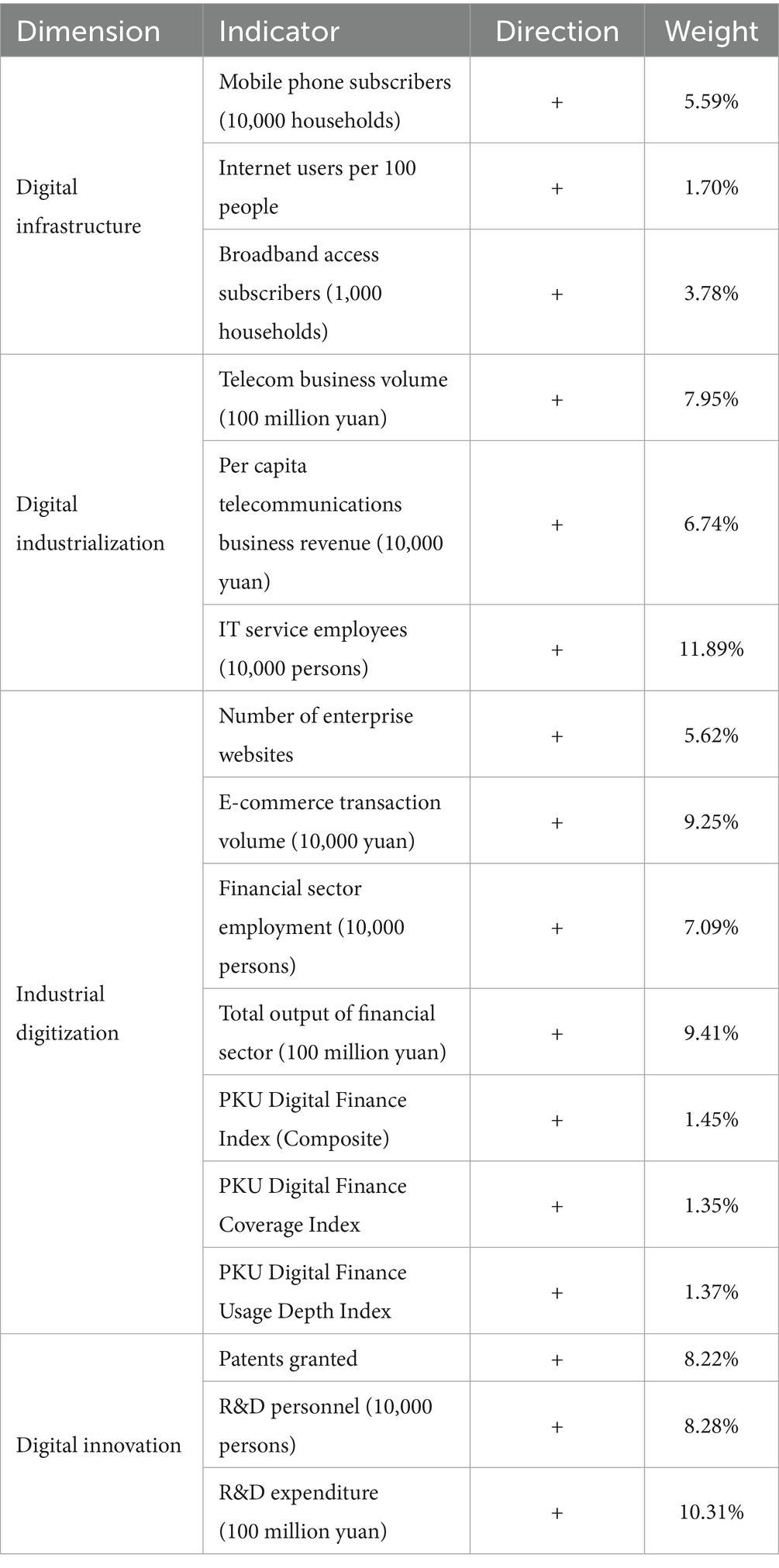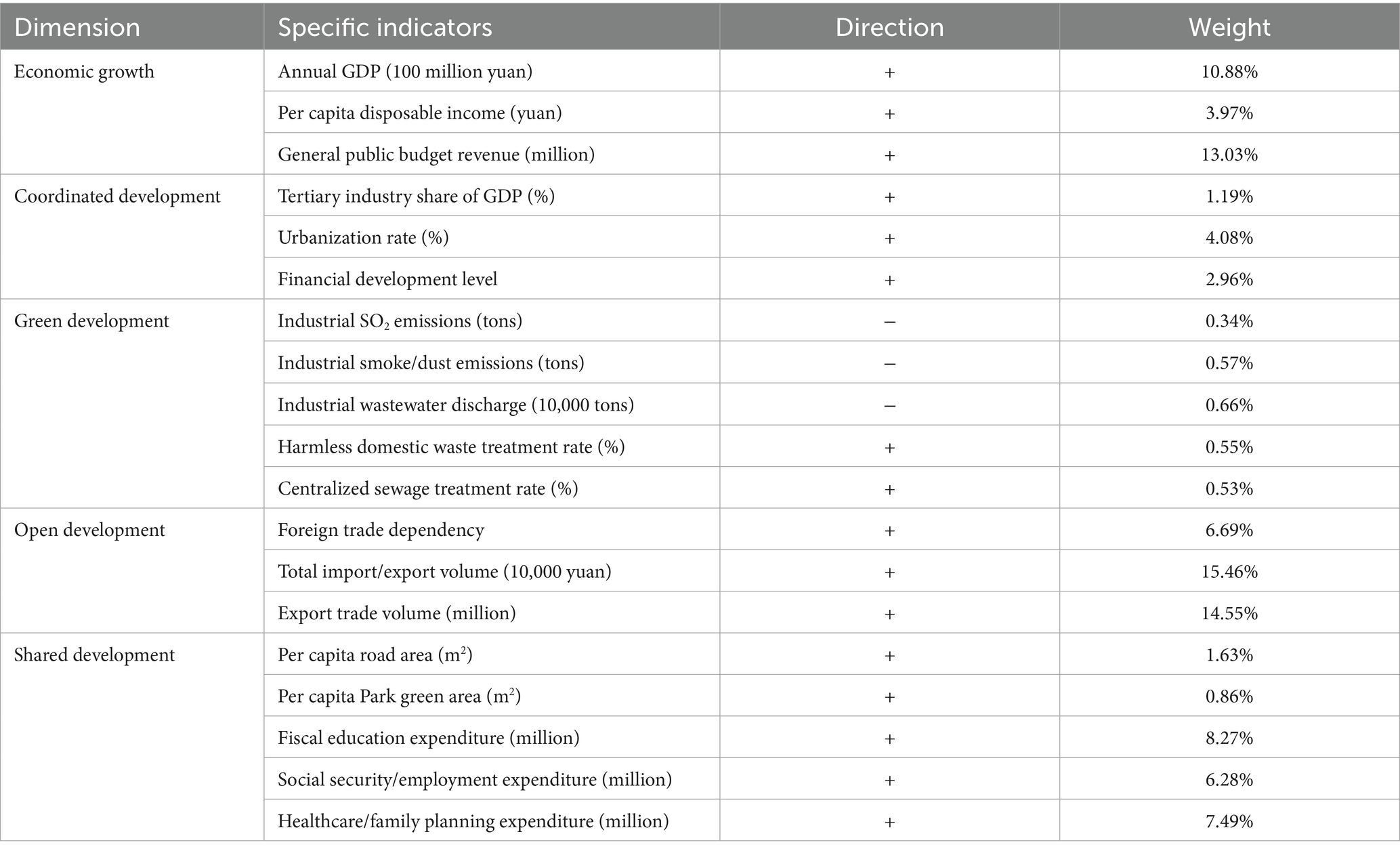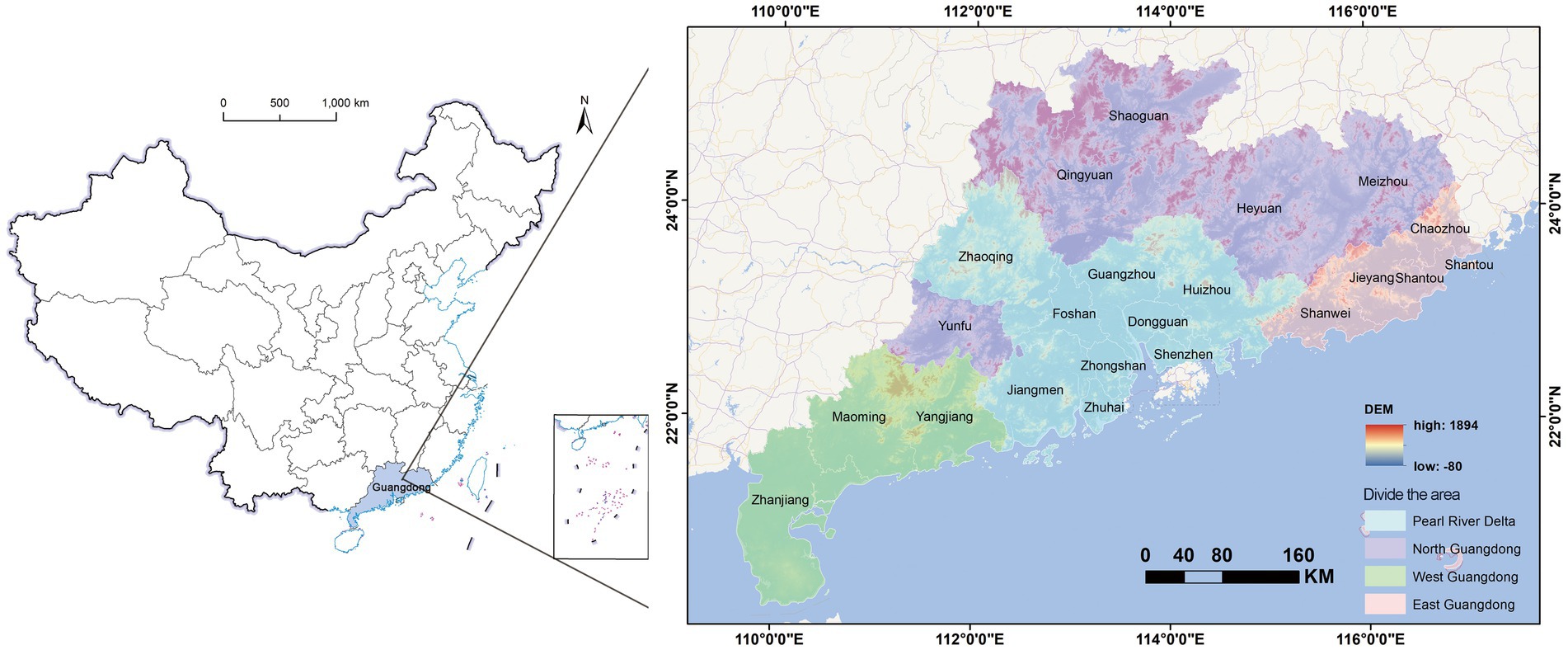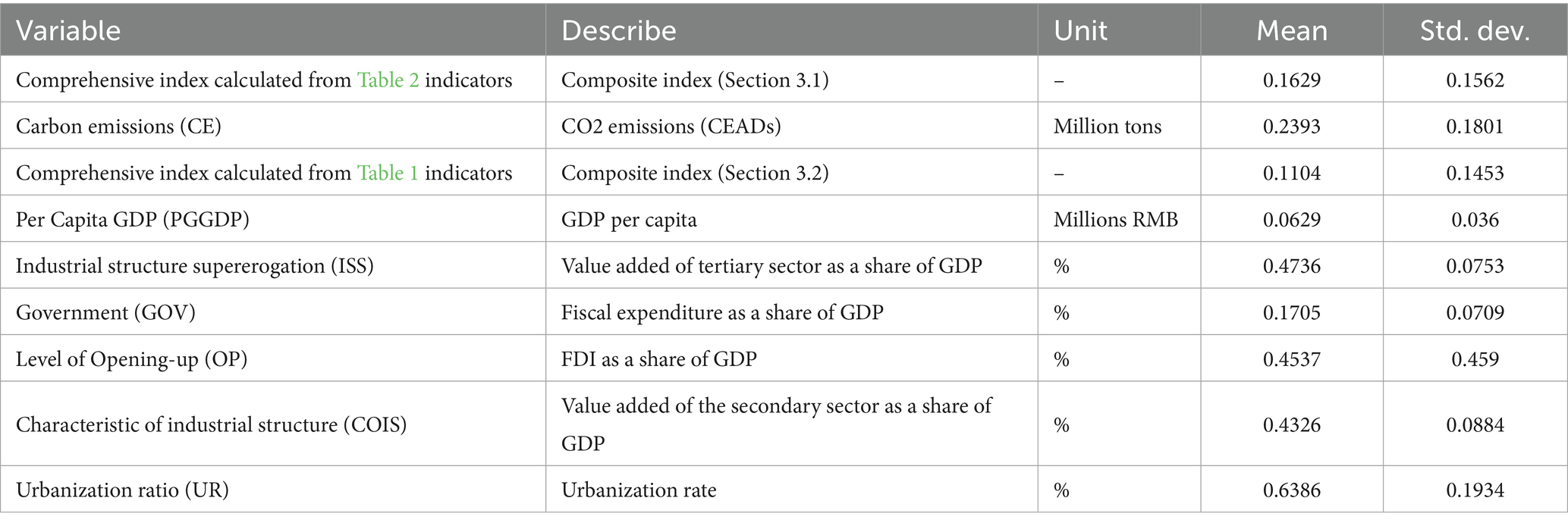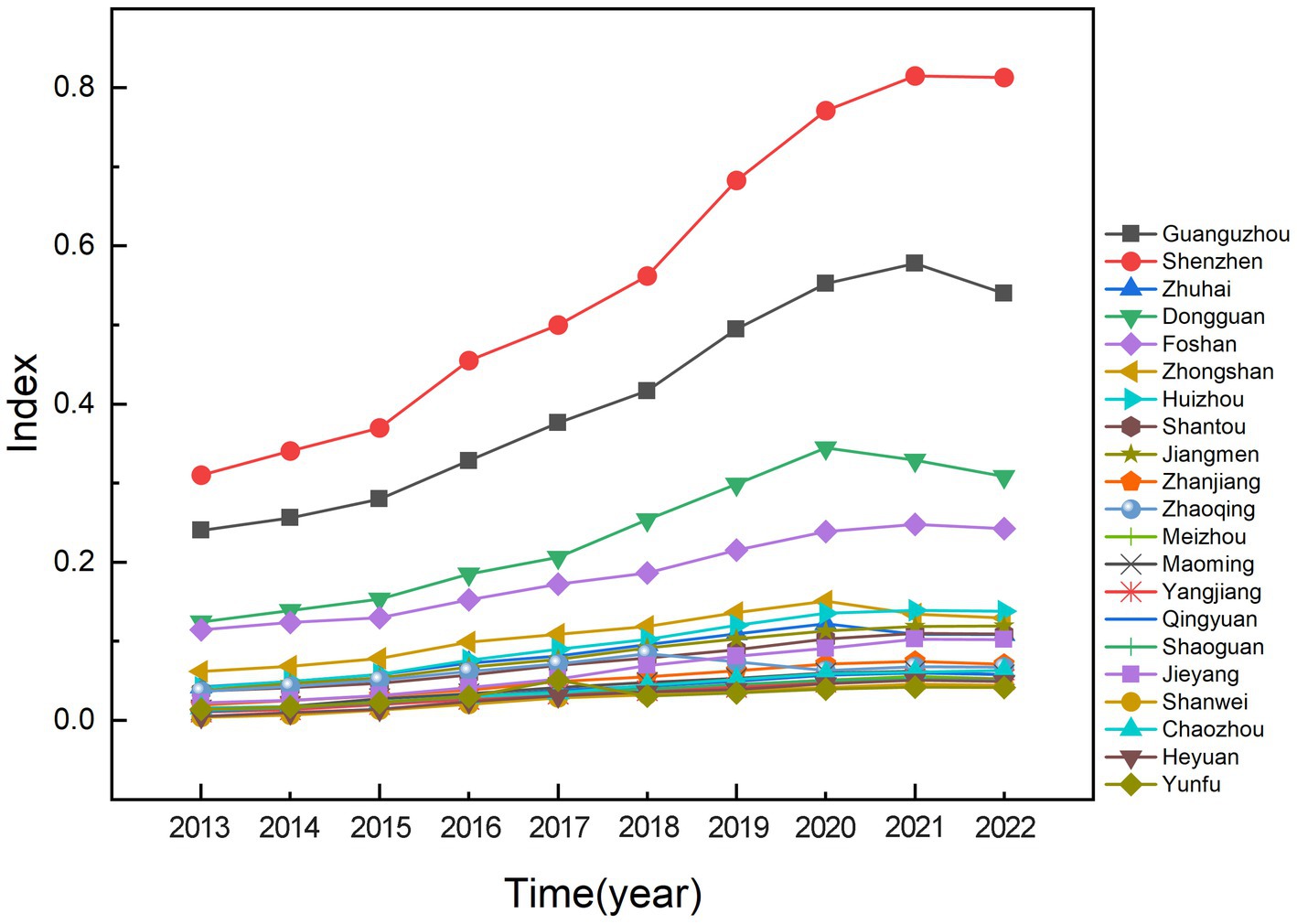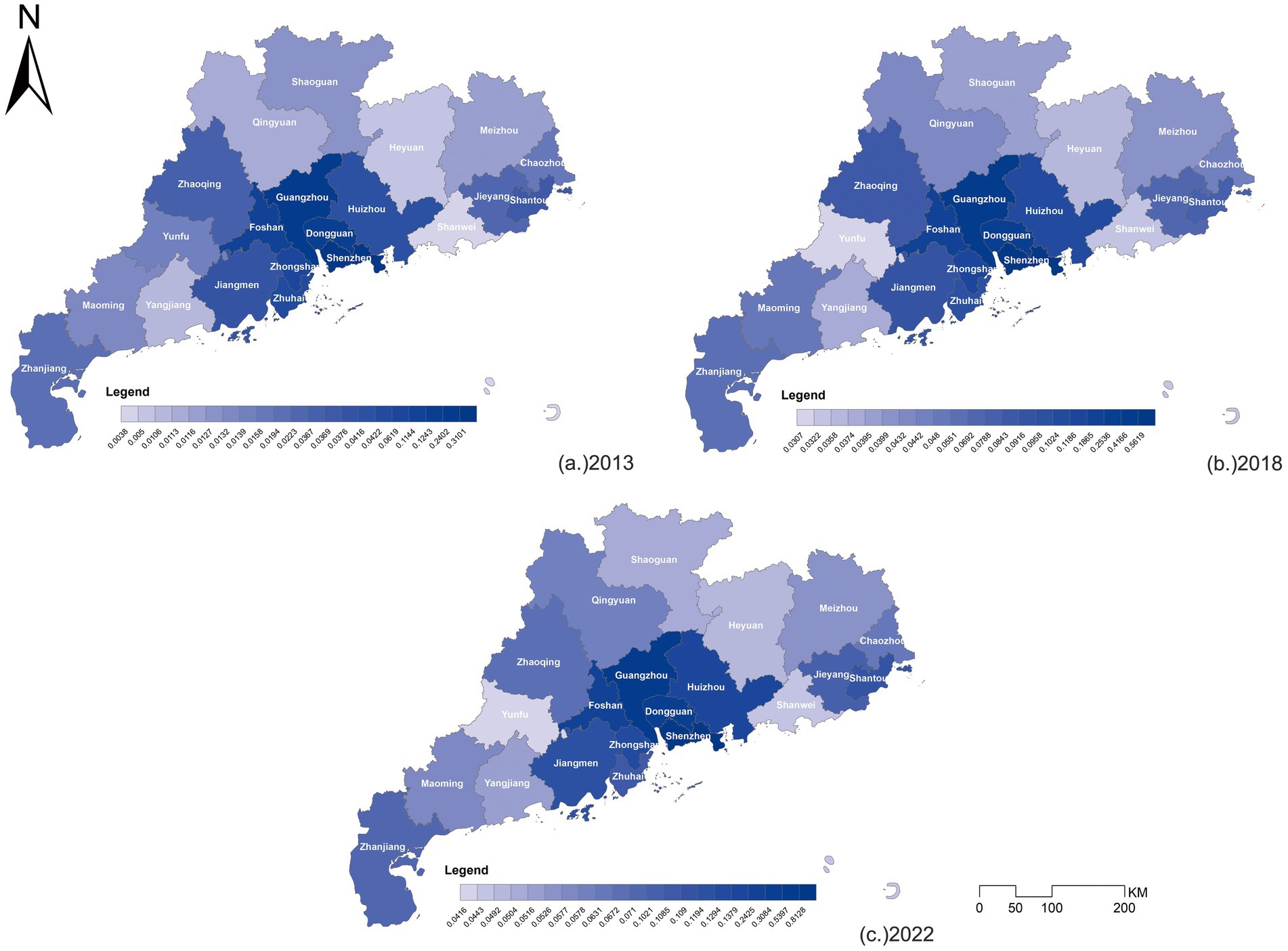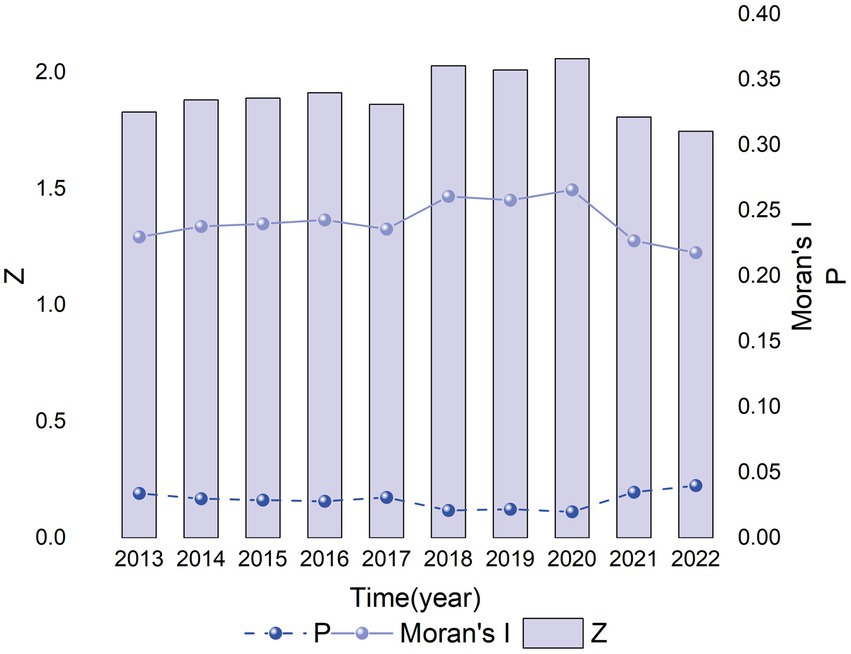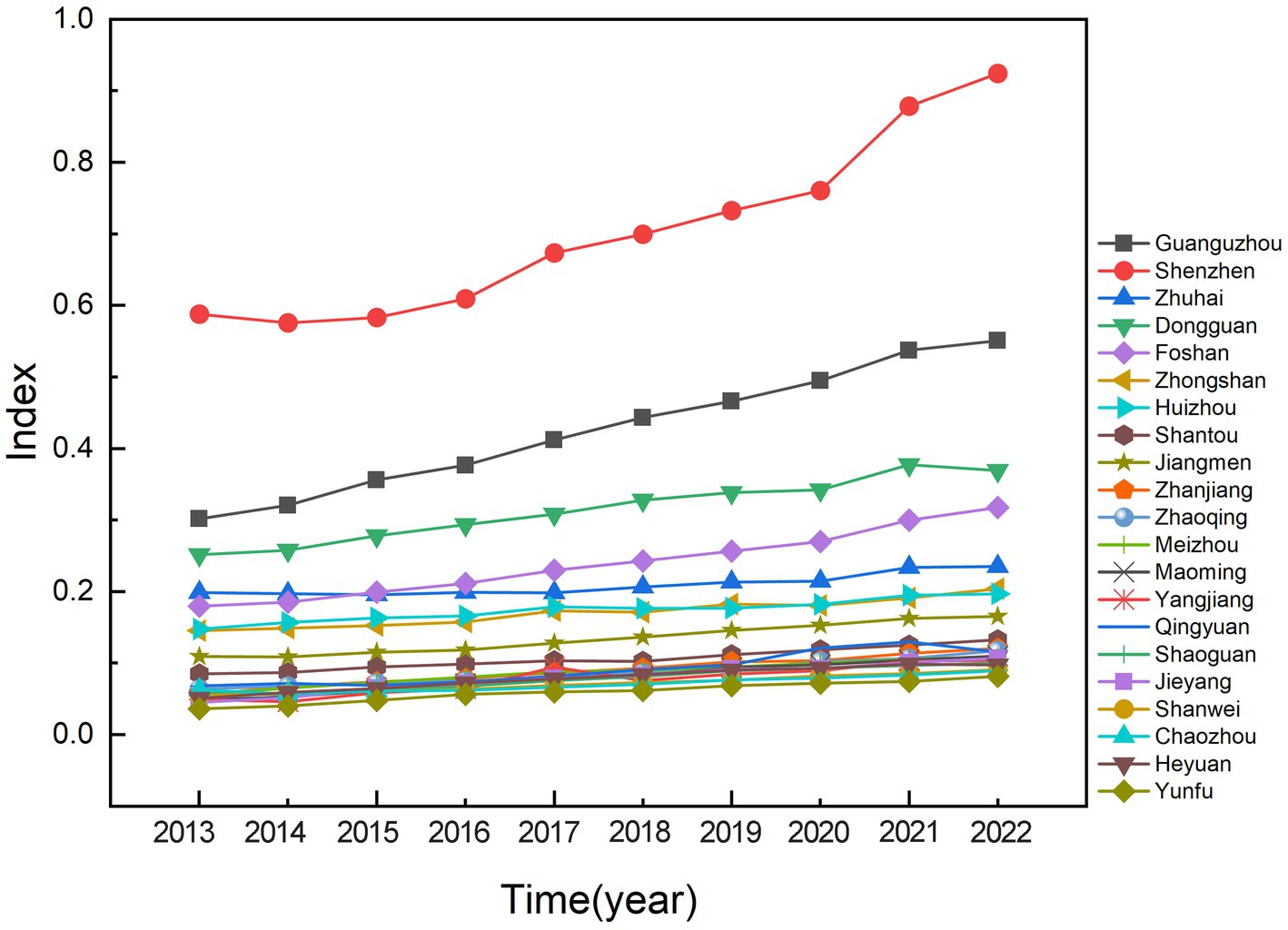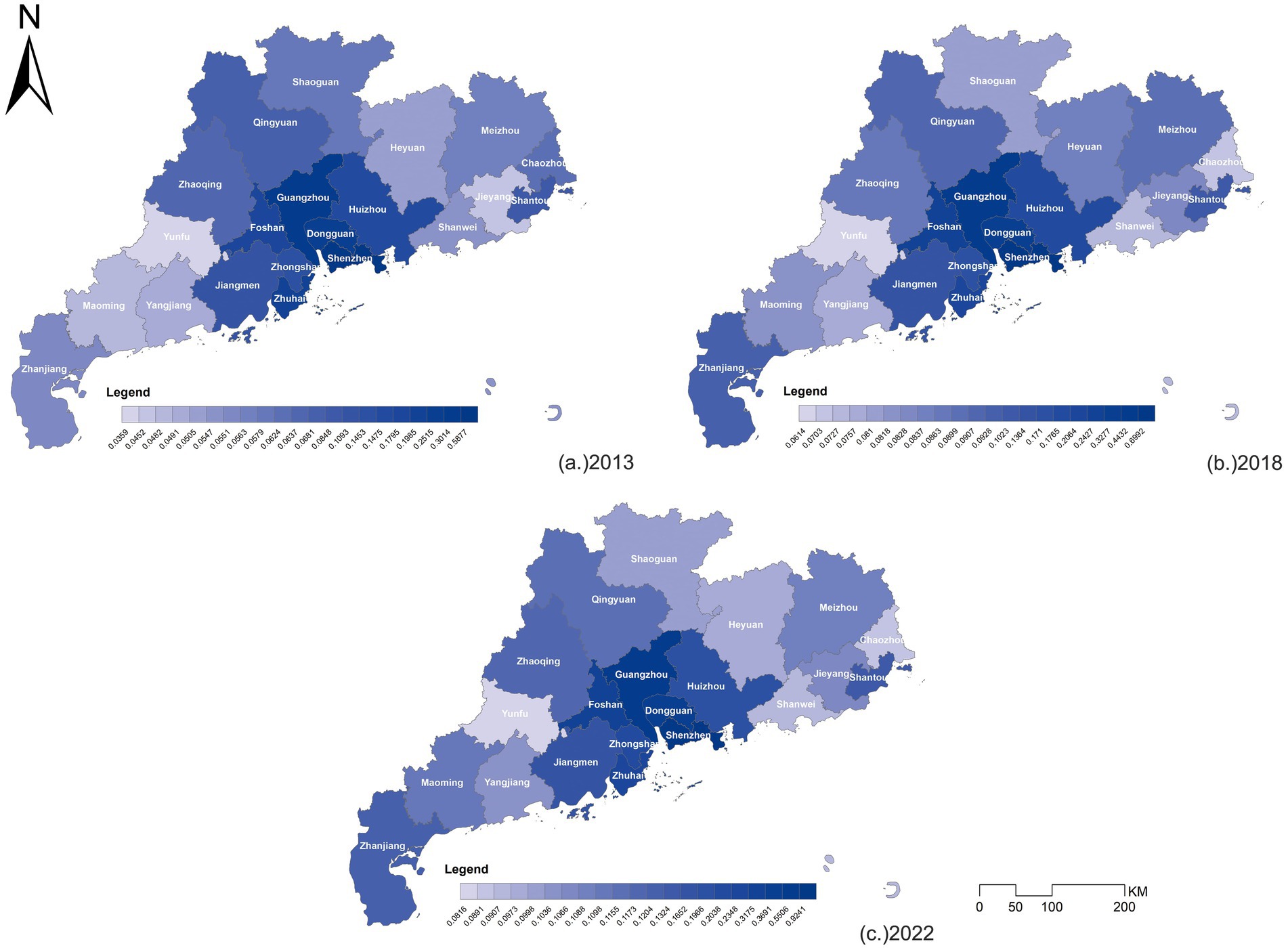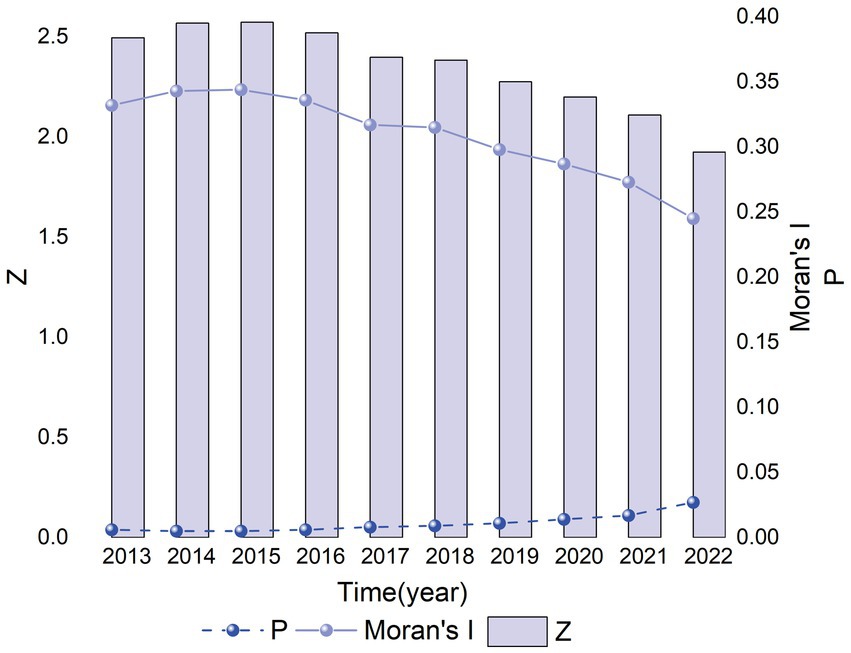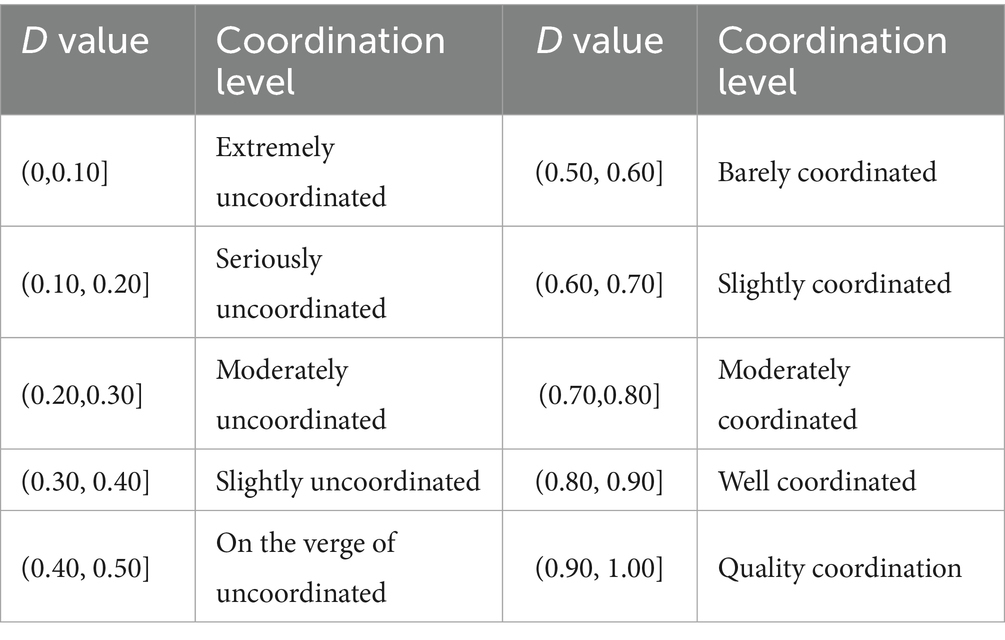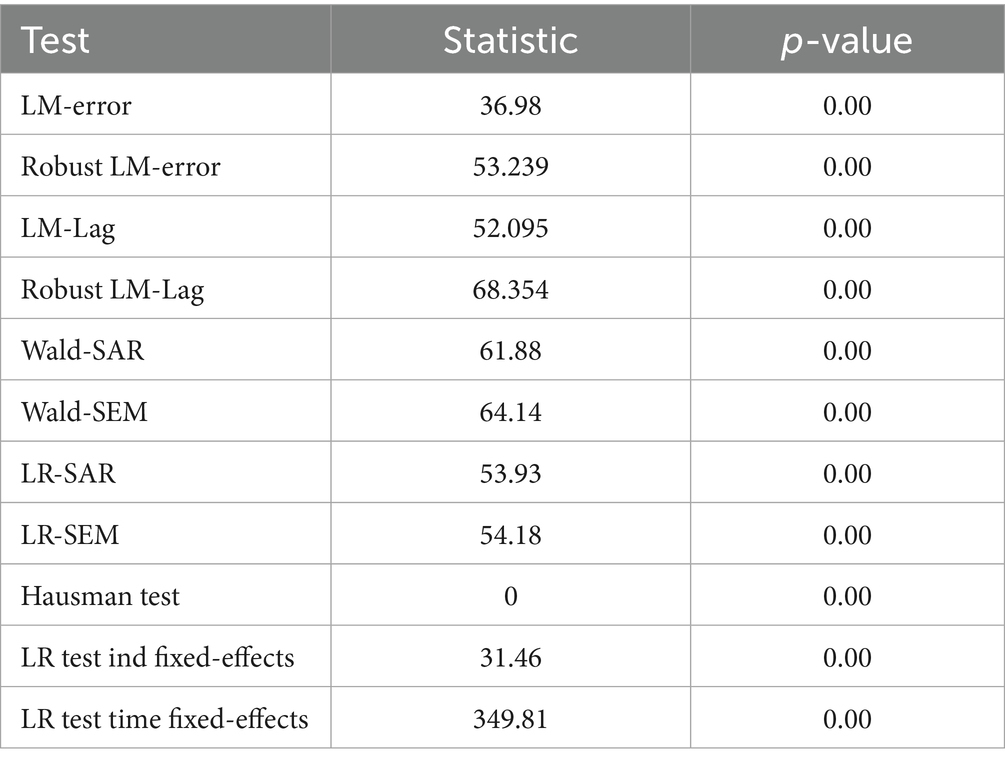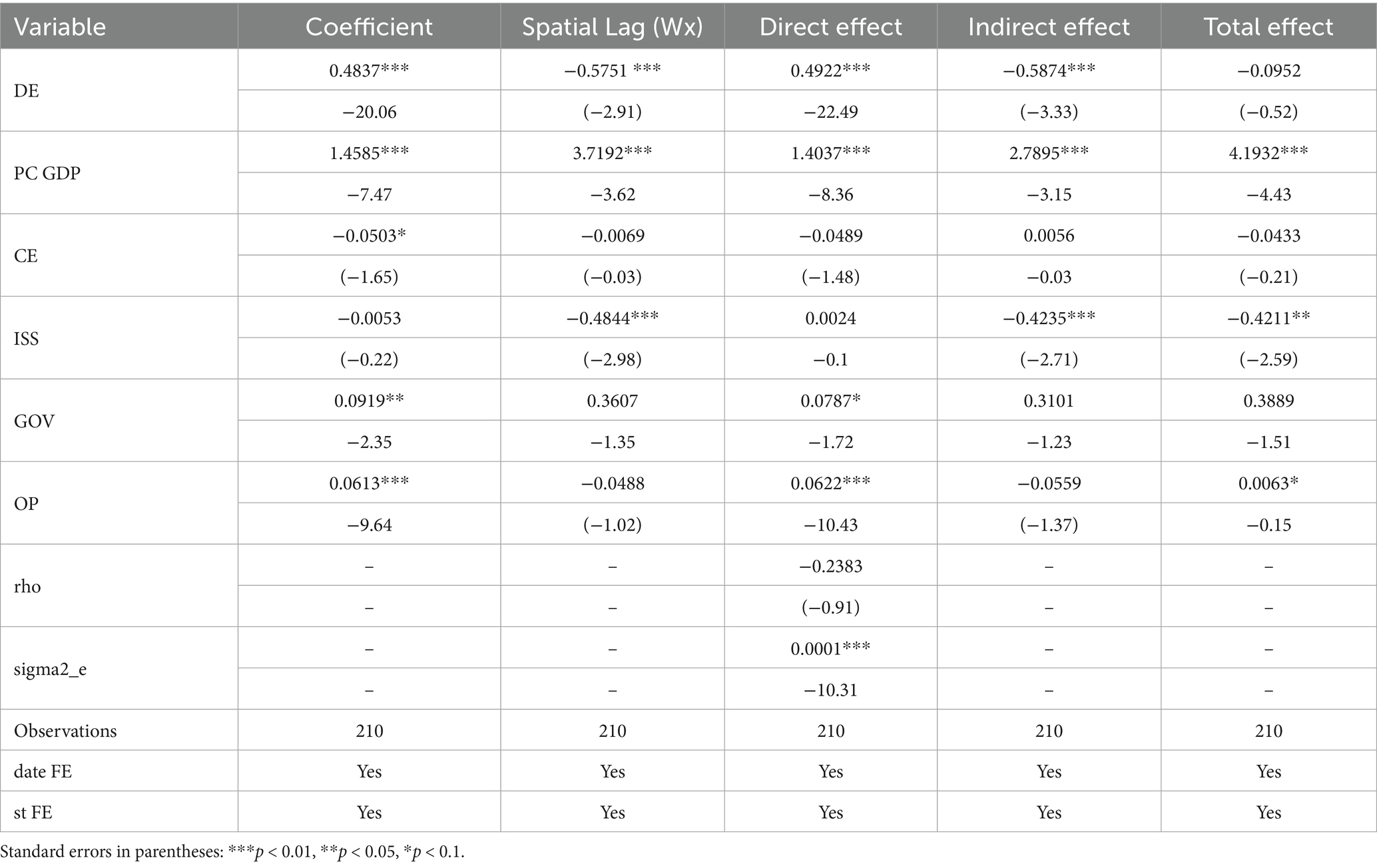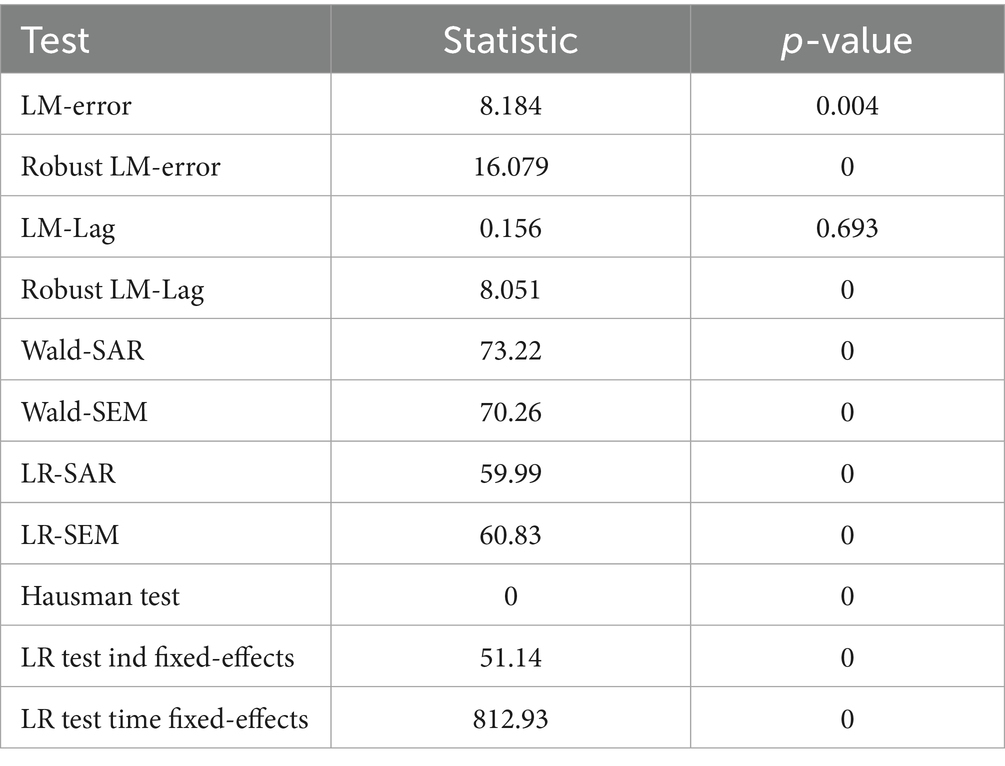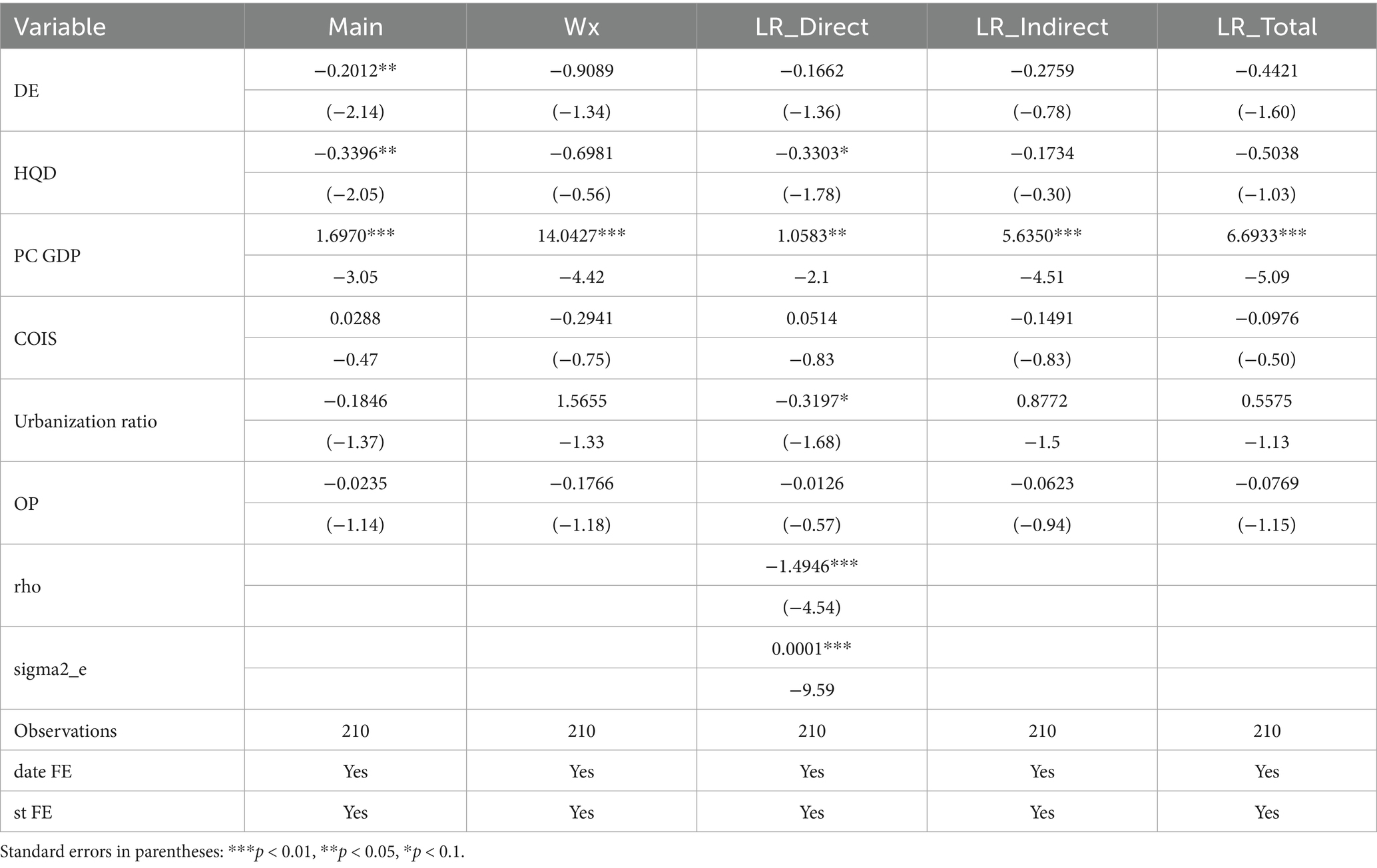- 1College of Architecture and Urban Planning, Kunming University of Science and Technology, Kunming, Yunnan, China
- 2Faculty of Science and Engineering, University of Nottingham Ningbo China, Ningbo, Zhejiang, China
The digital economy, as a sustainable and innovative mechanism for economic change, has emerged as a crucial national strategic driver for China’s attainment of high-quality development and low-carbon transition. Assessing the digital economy’s contribution to both high-quality development and carbon reduction, as well as evaluating the extent of its effects, can offer accurate decision-making assistance for prioritizing development sectors and optimizing resource distribution. This research utilizes the Entropy Weight TOPSIS approach and spatial autocorrelation analysis to investigate the spatiotemporal characteristics of the digital economy and high-quality development in Guangdong Province. A coupling coordination model evaluates the extent of coordination between the two, while a Spatial Durbin Model (SDM) is utilized to estimate the coefficients regarding the digital economy’s influence on both high-quality development and carbon emission reduction at the prefecture-level city size. The primary findings of the study are as follows: (1) Both the digital economy and high-quality development in Guangdong Province have progressively advanced, demonstrating notable spatial autocorrelation (Global Moran’s I ranging from 0.21 to 0.36, p < 0.01). Nonetheless, development r is uneven, with the Pearl River Delta region significantly outpacing other areas. (2) The coupling coordination level between the digital economy and high-quality development exhibits fluctuating stability and significant regional disparities. The Pearl River Delta, particularly Shenzhen and Guangzhou, consistently achieves a coordination quality level exceeding 0.90, whereas Meizhou and Maoming frequently fall below 0.20, indicating severe discoordination. (3) The digital economy has a substantial beneficial impact and spatial spillover effect on both high-quality development and carbon reduction. The SDM findings reveal that the digital economy exerts a substantial direct influence on high-quality development (coefficient = 0.4837, p < 0.01), while demonstrating a slight negative impact on carbon emissions (coefficient = −0.2012, p < 0.05), thereby affirming that its impact on high-quality development is predominantly more pronounced than its influence on low-carbon development. This report recommends focused ways to enhance the digital economy’s fundamental role in fostering high-quality development while also realizing its promise for low-carbon synergy.
1 Introduction
The emergence of the digital economy originated 1980s and 1990s, propelled by the development and extensive utilization of internet technologies. As a new form of green economy (Ma and Zhu, 2022), digital technologies have swiftly advanced throughout period, consistently creating novel production factors and business models. Today, the digital economy is now an essential element of regional economic development (Hu, 2023). China has advocated for the profound integration of the digital economy, achieving an annual growth rate of nearly 20%, thereby establishing it as a national strategy to unlock growth potential and spearhead global transformation. This plan aligns with global programs like Industry 4.0 in Germany, the technical policies of the United States and Russia, fostering a collective global consensus. In recent years, China’s digital economy has experienced substantial growth (Xue et al., 2022), attaining a magnitude of 50.2 trillion yuan in 2022, accounting for 41.5% of the country’s GDP. As of November 30, 2024, China possessed 4.5741 million core digital economy firms, reflecting a 17.99% increase from the end of 2023, with sustained development anticipated in subsequent years. Looking ahead, China will prioritize the industrialization of artificial intelligence and the commodification of data, positioning the digital economy as a fundamental element of future national development (Wang, 2024) and expediting its evolution into a “digital technology powerhouse.” Consequently, it is essential to construct a complete digital economy evaluation system and to analyze its development level objectively. These activities are crucial for advancing the high-quality development of the digital economy, improving international competitiveness, optimizing resource allocation, and fostering innovative capacity.
The digital economy acts as a complex facilitator of urban development, rejuvenating established industries, promoting the creation of new sectors, and improving governance capacity. This extensive transformation stimulates economic vitality and regional competitiveness. Moreover, the digital economy is crucial in promoting diverse developing economic models, including low-carbon development and high-quality growth. Carbon emissions are among the most pressing social and environmental issues worldwide. China, as one of the foremost carbon emitters globally, is diligently executing low-carbon development initiatives, robustly advocating for a low-carbon economy, and progressing toward sustainable development (Wang et al., 2021). The country is pursuing a low-carbon transition tailored to its own circumstances, aiming for “carbon peak” by 2030 and “carbon neutrality” by 2060. High-quality development has become a strategic objective as China transitions from a period of fast economic growth to a new stage of development. Historically, China’s economic growth has depended significantly on models characterized by high input, high consumption, and high pollution, which have become unsustainable. In response, the government has implemented a sustainable development strategy focused on innovation, coordination, green development, openness, and shared prosperity (Chen and Huo, 2022). This transition centers on a move from “quantity-driven” to “quality-driven” growth (Gong and Zhang, 2023). Advancing high-quality development is crucial for satisfying the increasing demand for a better life but also a prerequisite for sustainable development. Urban transformation toward high-quality development can significantly stimulate economic growth. In this context, the l sustained development of digital technologies establishes the digital economy as an essential avenue for attaining low-carbon goals. By utilizing digital technology to transform energy production, industrial operations, and consumption patterns, cities may attain the dual goals of sustainable growth and low-carbon development through coordinated, synergistic efforts.
The digital economy has evolved as a pivotal new economic forms and an essential element of contemporary economic systems, succeeding the agricultural and industrial economies. The digital economy, distinguished by significant innovation potential, robust penetration, and extensive reach, is emerging as a pivotal factor in the reorganization of global resource allocation and the transformation of global economic structure. A multitude of experts have investigated the correlation between the digital economy and high-quality economic development. Current studies demonstrate that the digital economy substantially fosters high-quality development (Xu et al., 2024; Chen and Xing, 2025). It accelerates economic transformation and facilitates sustainable development. Simultaneously, the worldwide focus on the low-carbon economy has significantly intensified in recent years, with numerous studies investigating the interplay between the digital economy and low-carbon development. Studies indicate that the digital economy can play a regulatory role in carbon emissions (Ma et al., 2025a; Wang et al., 2025), offering substantial policy support for long-term carbon reduction and promoting sustainable development. However, current studies also reveal that the impacts of the regional digital economy on carbon reduction and economic growth exhibit significant imbalances and heterogeneity (Ding et al., 2021; Tian et al., 2022). These disparities fundamentally illustrate structural variations in resource endowments, industrial frameworks, and institutional contexts across regions, which manifest in varied digital transformation outcomes.
Guangdong, as the vanguard of China’s reform and opening-up and the country’s largest provincial economy, occupies a crucial role in national development strategies. It excels in political sensitivity, economic reform, and developmental innovation. As the central engine of China’s digital economy and a model zone for high-quality development, Guangdong has attained significant accomplishments in the deep integration of the digital and real economies, industrial enhancement, and innovation-led growth. The province has implemented a holistic development framework defined by “manufacturing transformation + digital creativity + core technologies + regional collaboration.” In terms of carbon emission reduction, Guangdong has implemented the 2024–2025 Energy Conservation and Carbon Reduction Action Plan, which delineates specific targets for 2025: non-fossil energy consumption is projected to reach 32%, energy-saving renovations in key industries are expected to achieve savings equivalent to 3.5 million tons of standard coal, and carbon dioxide emissions are anticipated to be reduced by 9.1 million tons. Furthermore, Guangdong has significantly advanced in restructuring its industrial energy framework, enhancing technological innovation, encouraging regional collaboration, and bolstering green sectors, thereby establishing a robust platform for realizing the national “dual carbon” goals. Nonetheless, significant regional disparities persist in the integration of the digital economy and high-quality development within the context of carbon reduction. Substantial discrepancies endure between the Pearl River Delta and eastern, western, and northern Guangdong. The encounters problems, including significant push to modernize old businesses and obstacles in harmonizing cross-border data governance frameworks. These considerations render the process of coordinated development highly complex and regionally distinctive.
Examining the influence of the digital economy on both high-quality development and carbon reduction is of great significance, as low-carbon transition requires multidimensional coordination and is intricately connected to regional disparities. Comprehending these connections aids in pinpointing the origins of uneven and inadequate growth and offers a scientific foundation for devising tailored strategies to facilitate regional coordination and sustainable transformation in China. Previous research has investigated the digital economy’s role in promoting high-quality development or facilitating low-carbon transitions; however, the majority have addressed these two areas independently (He et al., 2025; Ye, 2025). Research has p predominantly been undertaken at the national or provincial scale, which overlooks the heterogeneity and specific transmission mechanisms observable at the prefecture-level city scale (Xie et al., 2025). Moreover, several studies concentrate on bilateral links such as the digital economy and high-quality development, or digital economy and carbon emissions, while neglecting to incorporate the three dimensions within a unified analytical framework (Ma et al., 2025b; Zheng et al., 2025). Consequently, a distinct gap persists in comprehending how the digital economy concurrently affects both high-quality development and carbon reduction, particularly at the city level. Addressing this gap is essential for elucidating the mechanisms through which the digital economy reshapes regional growth patterns, and for offering pragmatic direction to policymakers in balancing economic upgrading with low-carbon transition.
This study aims to overcome this gap by posing the following specific research questions: (1) Develop a detailed assessment index system to analyze the spatiotemporal characteristics and spatial effects of digital economy development and high-quality development across Guangdong’s prefecture-level cities. (2) Utilize the coupling coordination model to examine the extent of coupling and coordination between the digital economy and high-quality development in Guangdong. (3) Employ the Spatial Durbin Model (SDM) to evaluate the impact of digital economy development to both carbon emission reduction and high-quality development, and to ascertain if these impacts produce geographical spillover effects. This research seeks to address the existing gap in comprehending the mechanisms by which the digital economy influences both high-quality development and carbon reduction. The results are anticipated to yield significant insights and practical references for subsequent study in related fields.
2 Literature review
Since its introduction in 1996, the concept of the digital economy has rapidly evolved into a critical driver of global economic restructuring, characterized by strong innovation, wide penetration, and extensive coverage. Existing studies have examined its impacts from multiple perspectives. At the macro level, scholars have employed methods such as the entropy method, TOPSIS, DID models, and spatial econometrics to measure the scale and development of the digital economy, consistently finding that it significantly promotes industrial green transformation, urban sustainability, and resilience (Shi et al., 2023; Liu et al., 2024; Xie et al., 2025). Other works confirm its positive role in enhancing manufacturing efficiency, corporate ESG performance, and green innovation, often through mechanisms such as technological upgrading and increased R&D investment (Chen et al., 2022; Chen X. et al., 2023; Hao et al., 2023b).
More specifically, a substantial body of research links the digital economy to high-quality economic development. National-level analyses reveal its significant role in driving innovation, industrial upgrading, and regional convergence, with spatial spillovers evident between eastern and western China (Lu and Zhu, 2022; Pang et al., 2022; Shang et al., 2024). Disaggregated studies also highlight the contribution of digital inclusive finance and the synergy between digital economy development and green finance in improving green total factor productivity (Guo et al., 2022; Lee et al., 2023).
Meanwhile, increasing attention has been paid to the relationship between the digital economy and low-carbon development. Empirical studies demonstrate that the digital economy contributes to sustainable growth not only directly but also indirectly through industrial structure upgrading (Tan et al., 2024). It has been shown to reduce carbon intensity, foster low-carbon industries, and stimulate green innovation, although regional analyses also highlight the complexity and nonlinearity of these interactions (Li et al., 2023; Zhao et al., 2023; Sun et al., 2024). Furthermore, research on urban clusters such as the Yangtze River Economic Belt and the Yangtze River Delta illustrates how digital finance and digital economy development jointly enhance low-carbon efficiency and innovation, with evolving spatial dynamics over time (Yao et al., 2022; Wu and Pan, 2023).
In summary, prior research provides robust evidence that the digital economy fosters both high-quality and low-carbon development through diverse mechanisms. However, gaps remain regarding comparative assessments across different regions and economies, as well as the extent to which localized conditions mediate these effects. Building on these insights, the present study focuses on Guangdong Province, aiming to develop a locally grounded indicator system and employ multiple empirical approaches, including DID and structural equation modeling to systematically evaluate the relative impacts of the digital economy on high-quality and low-carbon development.
3 Materials and methods
3.1 Research area
Guangdong Province is located in southern coastal China, with a land area of 179,800 square kilometers and a population of approximately 127.8 million. The province is currently divided into four regions: the Pearl River Delta, Northern Guangdong, Western Guangdong, and Eastern Guangdong. As the forefront of China’s reform and opening-up and the country’s largest provincial economy, Guangdong has made significant progress in digital economy development, low-carbon transition, and high-quality growth in recent years. In 2023, the digital economy accounted for nearly 50% of the province’s GDP, while both the digital creative industry and intelligent manufacturing sectors formed trillion-yuan-scale ecosystems. Carbon emission intensity has also been significantly reduced, and a steady growth trajectory is expected to continue.
3.2 Data sources
This study uses three categories of data: socio-economic data, carbon emissions data, and high-quality development index data. The dataset covers 21 prefecture-level cities in Guangdong Province from 2013 to 2022. The raw data for the digital economy and high-quality development evaluation indicators were primarily obtained from the China City Statistical Yearbook, the Statistical Communiqués on National Economic and Social Development of Guangdong’s prefecture-level cities, and the Peking University Inclusive Finance Center, along with other official data platforms. Missing data were supplemented using linear interpolation. Carbon emissions data were sourced from the CEADs (China Emission Accounts and Datasets) platform. To improve the accuracy and reliability of data analysis, all numerical data were standardized through normalization processing.
To minimize potential biases in data collection, this study relies primarily on official statistical yearbooks and government databases, thereby avoiding self-reporting bias. Missing values in certain years or cities were addressed using linear interpolation, which is a widely accepted method in panel data research to preserve temporal continuity while minimizing distortion. These steps help to reduce non-response bias and ensure the robustness of the constructed dataset.
3.3 Method
3.3.1 Establish an evaluation index system for digital economy development and high-quality development
The digital economy is inherently complex, and it is difficult to comprehensively capture its development level using a single indicator. Current efforts to construct digital economy evaluation systems typically focus on multiple dimensions, including infrastructure, industrial integration, innovation capacity, and factor inputs. Drawing on the multidimensional indicator system established by Hao et al. (2023a), and referencing additional frameworks proposed by Su et al. (2021), as well as (Ren et al., 2022), this study defines four specific criterion layers: Digital Infrastructure, Digital Industrialization, Industrial Digitalization, and Digital Innovation. Digital Infrastructure reflects the foundational support for digital economy development and determines the potential upper limit of growth in other dimensions. Digital Industrialization measures the core scale and competitiveness of the digital economy sector itself, representing the degree of its industrialization and marketization. Industrial Digitalization captures the transformation of traditional industries through digital technologies, providing insight into the efficiency of industrial upgrading and the depth of digital integration in conventional sectors. Digital Innovation assesses the long-term development potential and technological breakthrough capacity of the digital economy. These four dimensions together form a closed-loop system for evaluating the digital economy, and only through coordinated measurement can the overall development level be accurately assessed. The specific indicators at the sub-layer level were determined not only by referencing existing indicator systems but also through extensive field research and policy review specific to Guangdong Province. Each indicator was evaluated for its systemic relevance, scientific validity, and practical operability. Ultimately, 14 specific indicators were selected, with the corresponding weights detailed in Table 1.
Since the concept of high-quality development was put forward by China at the 19th National Congress, its indicator system mainly refers to the existing Chinese literature and the specific generalization of high-quality development in the Party Congress. Ren et al. (2022), constructed a high-quality indicator system suitable for the Yellow River Basin, based on the five development concepts of “innovation, coordination, green, openness, and sharing.” Combined with the policy and economic development context of Guangdong Province and the Guangdong–Hong Kong–Macao Greater Bay Area, the guideline layers were determined as economic growth, coordination, green development, open development, and shared development. Economic growth is the core driving force of innovation, mainly measuring the quality and sustainability of development, and is the basis of economic development from “quantity” to “quality”; coordinated development is the core means of optimizing economic structure, which can solve the problem of unbalanced development and promote the synergy between urban and rural areas and regions, Green development is the bottom line of sustainable development, which is the same as the concept of low-carbon development, and it can improve resource efficiency and ecological protection at the same time, so as to realize the transformation of “green mountains are golden mountains”; open development is the source of improving international competitiveness, and it can improve international competitiveness and open up the system while preventing and controlling the risk, and improve the risk-resistant ability and quality in the process of opening up. Openness is the source of improving international competitiveness, risk prevention and control while improving international competitiveness and system openness, and improving risk resistance and international discourse power in openness; Shared development is the fundamental purpose of high-quality development, realizing common development and common prosperity, and focusing on measuring the fairness and universality of the development results. The specific indicators and related weights are shown in Table 2.
Since the concept of high-quality development was first proposed at the 19th National Congress of the Communist Party of China, its indicator system is primarily based on the existing Chinese literature and the official definitions outlined in the Party Congress reports. Drawing on the framework established by Ren et al. (2022) for the Yellow River Basin, and grounded in the “Five Major Development Concepts”—Innovation, Coordination, Green Development, Openness, and Sharing, this study further refines the system based on field research and policy analysis of Guangdong Province and the Guangdong-Hong Kong-Macao Greater Bay Area. Ultimately, five criterion layers are identified: Economic Growth, Coordinated Development, Green Development, Open Development, and Shared Development, comprising a total of 19 specific indicators. Economic Growth serves as the core driving force of innovation, focusing on the quality and sustainability of development and forming the foundation for transitioning from quantitative expansion to qualitative improvement. Coordinated Development is the central mechanism for optimizing economic structures, addressing imbalances, and promoting synergy across urban–rural, regional, and industrial sectors. Green Development represents the baseline for sustainability, aligning with the low-carbon development agenda. It emphasizes improving resource efficiency while protecting the ecological environment, embodying the principle of “lucid waters and lush mountains are invaluable assets.” Open Development enhances international competitiveness by promoting institutional openness while managing risks, thus strengthening resilience and China’s global discourse power. Shared Development reflects the fundamental goal of high-quality development, ensuring equitable distribution of development achievements and promoting common prosperity. It focuses on fairness and inclusivity in the sharing of growth outcomes. The specific indicators and corresponding weights are detailed in Table 2.
In this study, the measurement of variables follows established approaches widely adopted in the literature. The indicators for digital economy development and high-quality development are selected based on official statistical definitions and prior empirical studies (Ren et al., 2022; Hao et al., 2023a). The composite indices are constructed using the entropy-weighted TOPSIS method, which has been validated in numerous regional development assessments. All variables are standardized to ensure comparability across cities and years.
3.3.2 Entropy-weighted TOPSIS
The entropy-weighted TOPSIS method is a comprehensive evaluation technique integrating the entropy weight method and the TOPSIS method. The entropy weight method is used to determine the weight of each evaluation index, while the TOPSIS method is used to calculate the distance between each evaluation object and the ideal solution, so as to rank them. In this study, the entropy weight method was employed to determine the importance of each specific index of digital economy and high-quality development, so as to judge the importance of the index dimensions, to obtain the comprehensive index of digital economy and high-quality development of each prefecture-level city, and to analyze the process of spatial and temporal changes and trends.
To construct the digital economy index, this study employs the entropy-weighted TOPSIS method. First, the entropy method is applied to determine the objective weights of the selected indicators. Then, the weighted normalized decision matrix is obtained and used in the TOPSIS procedure. The relative closeness coefficient is calculated as:
3.3.3 Spatial autocorrelation
The global Moran’s I index is employed to detect spatial autocorrelation across the entire study area (Diniz-Filho et al., 2003). To capture the spatial dependence of regional economic development, this study applies both global and local Moran’s I indices. The global Moran’s I is defined in Equation (1):
3.3.4 Coupling coordination degree model
The coupling coordination degree model is utilized to analyze the level of coordinated development between systems. Coupling degree (C) quantifies the dynamic correlation and interaction between two or more systems that mutually influence each other to achieve coordinated development (Chen S. et al., 2023). It reflects the degree of interdependence and mutual constraint between these systems. The model mainly involves the calculation of three index values, which are coupling degree C, coordination index T value, and coupling coordination degree D value. The specific formulations are given in Equations (2)–(4). And finally combined with the coupling coordination degree D value and the coordination level classification standard, the final coupling coordination degree of each item is derived. This paper analyzes the coupling and coordination degree of digital economy and high-quality development, studies the development and change of the two, explains the internal mechanism of their synergistic development, can promote the formulation of policy differentiation, crack the problem of economic development imbalance, and promote the realization of multi-dimensional goals of high-quality development. Taking the binary coupling coordination model of digital economy and high-quality development as an example, the formula is as follows:
Where C is the coupling degree of digital economy and high-quality development and D is the coupling coordination degree of digital economy and high-quality development. and represent the digital economic development index and high-quality development index. Respectively; α and β refer to the weights of the digital economic development index and the high-quality development index, respectively; this study assumes that the digital economy and high-quality development are equally important, so it is made that α = β = 0.5. The coupling coordination degree D value is generally taken in the range of 0–1, the larger the value indicates the higher degree of coordination of the two systems (Figure 1).
3.3.5 Spatial Durbin Model
In this study, the Spatial Durbin Model (SDM) is further specified according to the research objectives and dataset. The empirical model is expressed as:
This study sets two dependent variables: High-Quality Development (HQD) and Carbon Emissions (CE). The measurement of high-quality development is conducted through five dimensions, with specific indicators and methodologies detailed in Section 2.2.1. Carbon emissions are measured using data from the China Emission Accounts and Datasets (CEADs). The Digital Economy (DE) Index serves as the core explanatory variable. To reduce potential confounding factors and improve the accuracy and stability of the estimation, several control variables are included to minimize omitted variable bias. These control variables are: economic development level (PC GDP), industrial structure upgrading (ISS), government intervention (GOV), level of opening-up (OP), industrial structure characteristics (COIS), and urbanization level (UR). The empirical analysis is conducted using ArcGIS 10.8 and Stata MP17, with panel data from the cities of Guangdong Province spanning 2013–2022. Table 3 presents the descriptive statistics of the sample.
4 Results
4.1 Spatio-temporal evolutionary characteristics of the digital economy development and high-quality economic development in Guangdong Province
4.1.1 Digital economy development index spatio-temporal characteristics
The digital economy index for each year was computed utilizing the Entropy Weight TOPSIS method, with the findings illustrated in Figure 2. The data reveal that the digital economy index across Guangdong’s cities has exhibited a general rising trend, characterized by annual fluctuations, signifying a positive and vigorous development trajectory. Guangzhou and Shenzhen are classified as first tier cities, demonstrating accelerated expansion. By 2022, both cities had attained a significant level of development, indicating their robust digital infrastructure. This has established a robust framework for the digital transformation of sectors. As initial pioneers in China’s reform and opening-up, these cities have robust economic foundations and have rapidly modernized conventional industries in reaction to the digital economy surge, facilitating the development of novel business models. Furthermore, identified as pilot zones for the digital business, these locations enjoy advantageous policy frameworks, encompassing governmental backing via financial incentives and regulatory enhancements in data security and privacy protection, which have bolstered market confidence. Their strategic position inside the central region of the Guangdong-Hong Kong-Macao Greater Bay Area, with proximity to the South China Sea, enhances industrial advancement, cross-border interaction, and pragmatic cooperation. The secondary tier comprises cities including Foshan, Dongguan, Zhuhai, Zhongshan, Huizhou, Shantou, and Jiangmen. Despite their initial developmental delay compared to Guangzhou and Shenzhen, these cities have achieved considerable advancements in digital economy development by 2022, significantly improving local industry digitalization with considerable growth potential. These regions have profited from the spillover effects of the Guangzhou-Shenzhen-Hong Kong-Macao Science and Technology Innovation Corridor, where the digital economy’s expansion in Guangzhou and Shenzhen has expedited local industrial development. Moreover, local governments have proactively facilitated this transformation by instituting a series of experimental projects designed to advance the digitalization of conventional businesses. Conversely, places like as Maoming and Yunfu remain in the lower tier, characterized by fragile digital industry foundations and slow index growth. In recent years, their digital economy development has been unimpressive however demonstrates a gradual upward trajectory. These areas are primarily hilly, characterized by intricate terrain and challenging transportation, which leads to higher costs and greater difficulty in building digital infrastructure. Their economy mostly relies on agriculture, resource-based industries, and low-end manufacturing, where tiny firms frequently lack the financial means and technological capabilities for sophisticated advancements. Moreover, the spillover of the digital economy from developed cities like Guangzhou and Shenzhen predominantly benefits adjacent cities such as Dongguan and Huizhou, resulting these less developed regions with limited capacity to absorb and leverage digital industry expansion.
The digital economy index for the years 2013, 2018, and 2022 was illustrated using ArcGIS, with the results presented in Figure 3. The chart illustrates that the regions exhibiting the highest levels of digital economy development are continually concentrated in the Pearl River Delta. In eastern Guangdong, the majority of cities demonstrate comparatively elevated digital economy indices, with the exception of Shanwei. Conversely, northern and western Guangdong have consistently low levels of digital economy development, characterized by sluggish rise in index values over time. The swift advancement of the digital economy in the Pearl River Delta is chiefly ascribed to its position as China’s central manufacturing center, characterized by a comprehensive industrial chain and a well-established supply system. This industrial foundation offers numerous application scenarios for digital transformation, expediting the incorporation of digital technology into conventional sectors. Furthermore, both national and Guangdong province governments have implemented a range of supportive policies aimed at fostering digital economy growth, leading to a more optimized strategic layout for the region’s digital progress.
A Global Moran’s I analysis was performed and presented, as shown in Figure 4, to investigate the spatial agglomeration of the digital economy in Guangdong Province. The findings demonstrate that from 2013 to 2022, the Moran’s I values constantly exceeded zero, indicating a positive spatial autocorrelation in the advancement of the digital economy throughout the province. The Z-scores exhibit an early increase followed by a subsequent decrease. Between 2013 and 2020, the Z-scores rose, indicating a phase of heightened spatial agglomeration characterized by the concentration of resources and digital economic activities in the Pearl River Delta region. At this level, core-periphery polarization was notably prominent. Subsequent to 2020, the Z-scores commenced a fall, signifying a diminishment in the importance of geographical grouping. The data distribution grew increasingly randomized, and spatial reliance decreased. This pattern indicates a progressive diminishment of regional differences in Guangdong’s digital economy. The execution of programs advocating industry migration and infrastructure improvement has begun to strengthen formerly poor regions, indicating preliminary progress in encouraging coordinated regional development.
To further identify the specific spatial clusters of digital economy development in Guangdong Province, a Local Moran’s I analysis was conducted on the digital economy index, with representations generated for the years 2013, 2018, and 2022, as shown in Figure 5. The findings indicate that the “High-High” clusters are regularly situated in Dongguan, signifying that the city possesses a significant level of digital economy growth and is encircled by comparably advanced bordering cities. This phenomenon is chiefly attributable to Dongguan’s status as a significant center for China’s electronic information manufacturing sector, accommodating prominent companies like Huawei and OPPO. The city advantages from a robust industrial agglomeration effect, and its closeness to Guangzhou and Shenzhen allows it to assimilate spillover resources from these core digital economy hubs, thereby enhancing regional industrial linkages. Moreover, Dongguan possesses extensive policies and infrastructure that facilitate its significant digital economic growth. Huizhou is classified as a “Low-High” cluster, indicating that despite its proximity to Shenzhen, it has not completely used the spillover benefits from the core cities. The industrial framework is predominantly characterized by conventional manufacturing, and the pace of digital transformation has been comparatively sluggish. The “Low-Low” clusters have shifted from Meizhou to Maoming in recent years. These regions are marked by intricate topography and inadequate infrastructure, resulting in comparatively worse economic conditions. Consequently, they possess restricted capacity to absorb industrial spillovers from Shenzhen and Guangzhou, resulting in consistently modest degrees of digital economy development. Furthermore, the adjacent regions likewise display comparably poor digital economy indices, creating a concentrated development zone of underdevelopment.
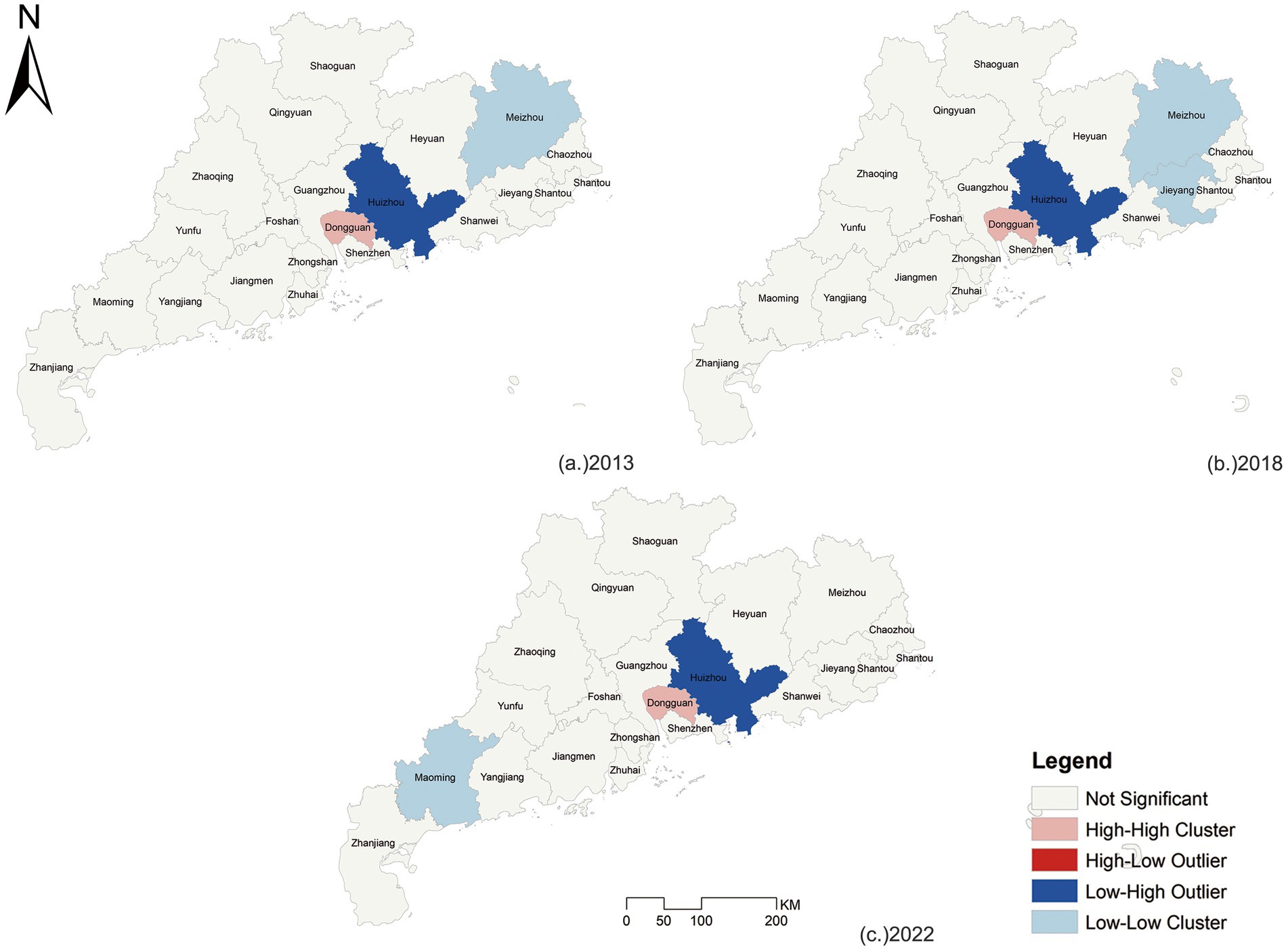
Figure 5. Local Moran’s I analysis of digital economy development in Guangdong Province across 2013, 2018, and 2022.
4.1.2 High-quality development index spatio-temporal characteristics
Similarly, the High-Quality Development Index of Guangdong Province was computed utilizing the Entropy Weight TOPSIS method, and the findings were illustrated in Figure 6. The results indicate a pattern of polarization in high-quality development throughout the province. Shenzhen distinguishes itself with a markedly elevated baseline and accelerated development, asserting its position as the unequivocal leader in Guangdong. The city has cultivated a vibrant, enterprise-driven innovation ecosystem and is ranked among the national leaders in R&D and technological innovation. The government not only offers preferential support to industry-leading firms but also actively fosters small and medium-sized enterprises. Shenzhen leads China in foreign trade volume and possesses significant worldwide talent attraction capabilities, establishing itself as a hub for international talent and a pivotal participant in global resource allocation. The Pearl River Delta region, propelled by Shenzhen, demonstrates a substantial development base and rapid growth rate, resulting in a high-quality development urban cluster in recent years. This progress is attributable not just to Shenzhen’s leadership but also benefits from the region’s open economy and its strategic position in enhancing integration with Hong Kong and Macao via diverse collaboration platforms. The Pearl River Delta exhibits advanced urban governance, marked by significant accomplishments in smart city initiatives, extensive utilization of new energy vehicles, and a comprehensive promotion of green structures, establishing national benchmarks. Conversely, several areas in Guangdong have had comparatively mediocre results in high-quality development. Geographic location and underlying infrastructure constraints have hindered their capacity for quick expansion, leading to stasis in their pursuit of high-quality growth.
The High-Quality Development Index for 2013, 2018, and 2022 is illustrated in Figure 7. The maps demonstrate that, over time, the overall level of high-quality development in Guangdong Province has shown an upward trajectory, with the index values rising throughout the province. The spillover impact of the Pearl River Delta has led to an increase high-quality development indices across all prefecture-level cities; yet, the growth rate exhibits considerable regional variation. Specifically, Yunan City (Yunfu) has undergone exceedingly sluggish expansion. The city’s sluggish development is primarily attributable to its geographic constraints, as over 90% of Yunfu’s land area is mountainous, hence providing minimal flat terrain for industrial development and urban expansion. The elevated expenses of transportation and logistics further constrain its industrial configuration and urbanization process. Moreover, Yunfu’s industrial framework is significantly reliant on conventional resource-based sectors, including stone processing and sulfur chemical manufacturing. These industries are defined by minimal technological sophistication and are progressively governed by environmental restrictions, leading to comparatively poor economic output.
To further analyze whether high-quality development in Guangdong Province exhibits spatial correlation, the Global Moran’s I was computed and illustrated, as depicted in Figure 8. The results demonstrate that the Moran’s I values for high-quality development continuously exceed zero, indicating the existence of a positive spatial clustering effect. Nonetheless, the Moran’s I values have progressively diminished over the years, signifying a transition from concentrated to more dispersed growth patterns, accompanied by a greater coordination of regional development. In recent years, Guangdong Province has vigorously advocated for equitable development across its eastern, western, and northern. Efforts to reduce the economic disparity between the Pearl River Delta and other regions have been undertaken through industrial relocation, infrastructure investment, and policy support. The distribution of rising industries has grown more equitable, no longer confined to places like Shenzhen and Guangzhou, but extending to regions such as Zhuhai and Foshan. The reduction in the Moran’s I values signifies both the effects of intentional policy interventions but also the outcomes of market-driven changes, fostering a more balanced regional development environment (Figure 9).
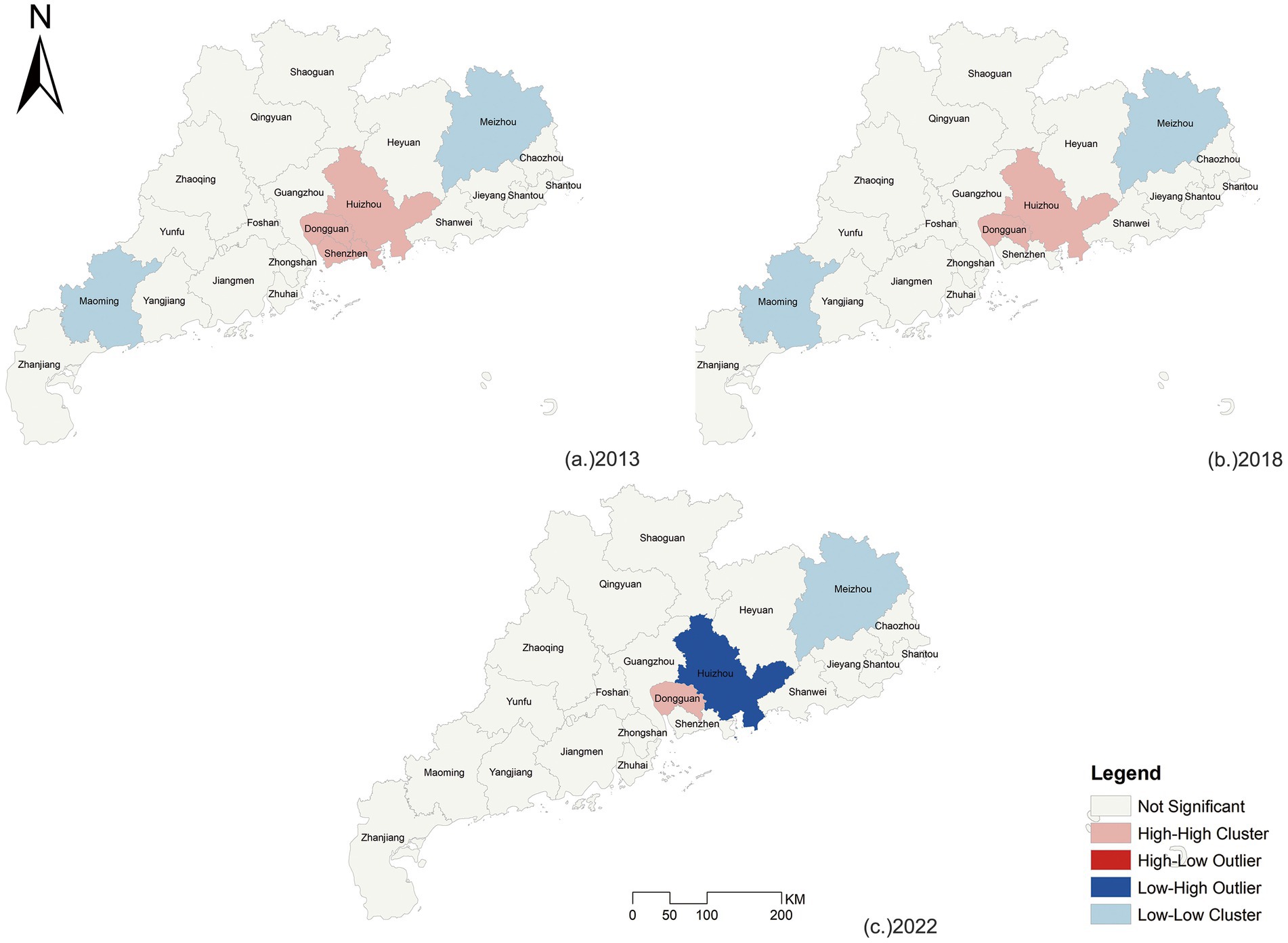
Figure 9. Local Moran’s I analysis of high quality development in Guangdong Province across 2013, 2018, and 2022.
The consistently positive Global Moran’s I values for high-quality development indicate broad spatial association; thus, a Local Moran’s I analysis was performed to pinpoint the clustering patterns of high-quality development throughout Guangdong Province. The outcomes for 2013, 2018, and 2022 are visualized in figure. The results indicate that the “High-High” clusters of superior development have persistently been centered in the Pearl River Delta region. However, Huizhou has transitioned from a “High-High” cluster to a “Low-High” cluster throughout time. In recent years, Guangzhou and other principal cities have enacted regional coordination plans to mitigate the developmental disparity between the Pearl River Delta and non-Delta regions. As a peripheral city of the Pearl River Delta, Huizhou initially profited from the spillover effects of neighboring high-growth cities. Nonetheless, the implementation of industrial relocation and spatial spillover strategies from Guangzhou and Shenzhen has resulted in certain regions of Huizhou failing to fully align with the new developmental momentum, causing a decrease in the overall intensity of high-quality development and leading to the emergence of the “Low-High” clustering pattern. By 2022, the “Low-Low” clusters have shifted from encompassing both Meizhou and Maoming to exclusively covering Maoming. This transition signifies that Meizhou has progressively attained enhanced regional coordination with its surrounding areas. Influenced by targeted regional development policies, Meizhou has advanced in infrastructure construction and industrial development due to targeted regional development plans, achieving a more balanced growth state, and is no longer being part of a substantial low-level cluster.
4.2 Coupling coordination analysis between the digital economy and high-quality development
According to the study by Qi et al. (2022), the coupling coordination degree (D value) is classified into 10 stages, spanning from severe imbalance to high-quality coordination, as illustrated in Table 4. A greater D value signifies an improved degree of coupling coordination. Based on this classification, the coupling coordination analysis between the digital economy and high-quality development in Guangdong Province was performed using SPSS AU software, with the results displayed in Table 5.
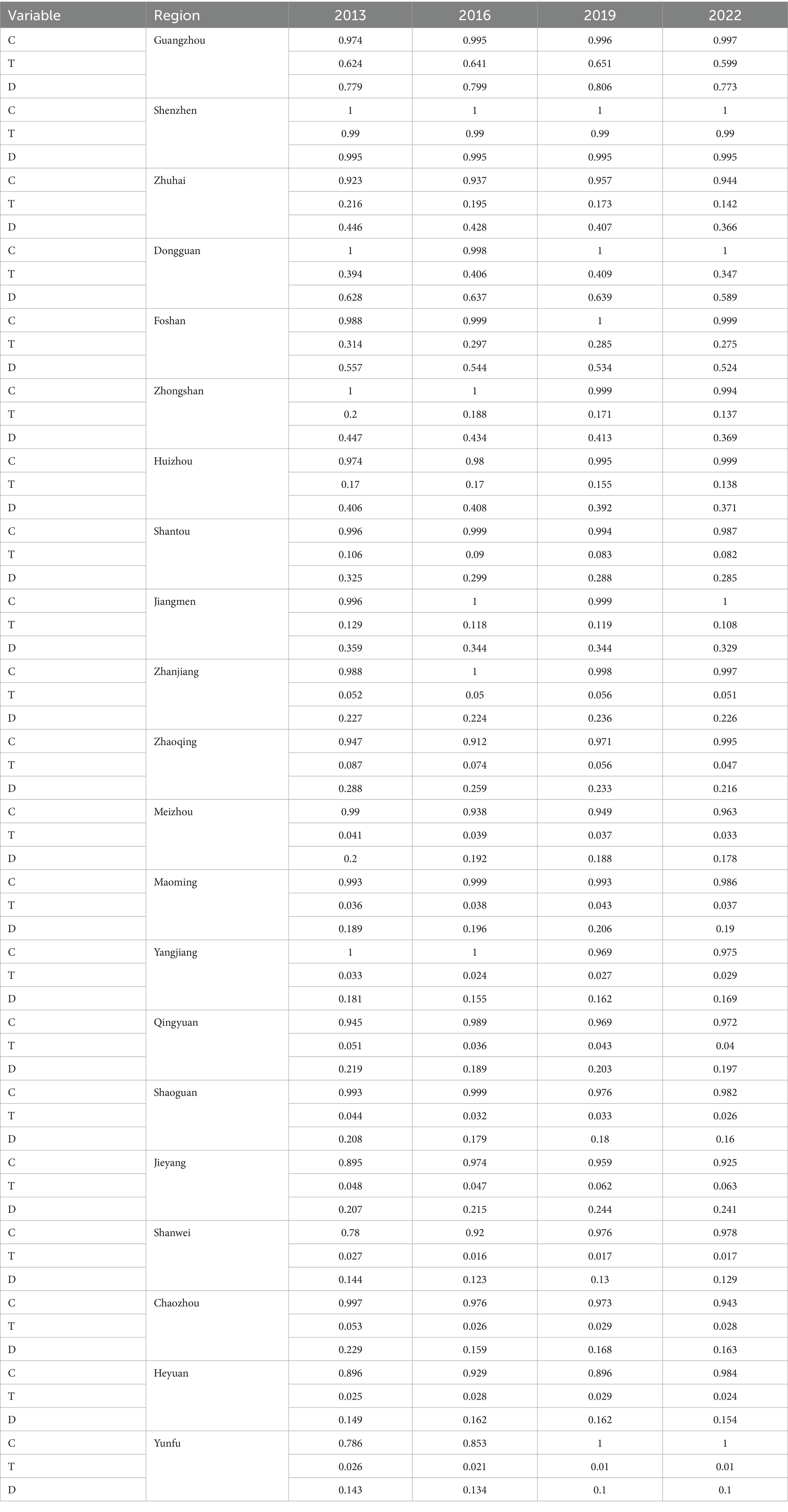
Table 5. The coupling coordination degree between digital economy development and high-quality development in Guangdong.
From the standpoint of spatial–temporal variations in coupling coordination, the D values of Guangdong Province exhibited a fluctuating but predominantly stable tendency at a reasonably elevated level between 2013 and 2022. The Pearl River Delta region had markedly elevated D values, with Shenzhen and Guangzhou routinely achieving the “quality coordination” level (D > 0.9), signifying a mature and steady integration between digital economy advancement and high-quality growth. Conversely, some regions demonstrated diminished coupling coordination levels, predominantly classified as “barely coordinated” to “moderately uncoordinated.” For instance, Meizhou, Maoming, and Yunfu exhibited persistently low D values, frequently below 0.2, remaining at the “seriously uncoordinated” level. Cities such as Zhuhai, Zhongshan, and Huizhou fluctuated between “on the verge of uncoordinated” and “barely coordinated,” indicating disparities in regional growth.
The Pearl River Delta has continually exhibited a high level of coupling coordination, attributable to factors such as its industrial structure, policy backing, developmental foundation, and geographical advantages. The region’s abundant resources and a strategic location have cultivated a beneficial cycle among digital economy growth, infrastructure enhancement, and comprehensive regional advancement, allowing it to achieve a leading level of coupling coordination. In contrast, the regions of northern, western, and eastern Guangdong have consistently exhibited lower levels of cooperation. This is likely attributable to their designation as economically underdeveloped areas within the province, characterized by inadequate digital infrastructure and comparatively low levels of industrial development. Shantou, previously designated as “on the verge of coordination” in 2013, has subsequently regressed to the “seriously uncoordinated” classification. This downturn is mostly due to compounding problems, such as repeated infrastructure deficiencies, unbalanced industrial development, increasing regional competition, and a lack of effective policy synergy. Overall, the spatial pattern reveals a “core-periphery” distinction, with the Pearl River Delta serving as the core area of high coordination, but eastern, western, and northern Guangdong continue to fall behind in the integration of digital economy development with broader socio-economic advancement. This regional gap underscores the pressing necessity for governmental interventions to foster equitable digital transformation throughout the province.
4.3 Empirical analysis of digital economy and high-quality development and carbon emissions based on SDM
This work utilizes the Spatial Durbin Model (SDM) for empirical analysis to quantitatively evaluate the influence of digital economy development on high-quality development and carbon emissions in Guangdong Province, while also investigating its spatial spillover effects. The SDM facilitates the analysis of both direct effects and indirect effects, also known as spatial spillovers, which reflect the influence on adjacent cities. This offers an in-depth comprehension of the relationships among the digital economy, regional high-quality development, and carbon emissions. This study constructs two distinct regression models, with high-quality development and carbon emissions serving as the dependent variables, respectively. This facilitates a comparative investigation of the digital economy’s impact on both results and the variations in regional effects. The findings of this analysis will elucidate the complex role of the digital economy in fostering sustainable development, providing empirical support for the synchronized progression of green and high-quality growth.
4.3.1 Spatial spillover effects of the digital economy on high-quality development
To assess the presence of spatial effects exist in the data and to inform further model selection, LM tests, Wald tests, and LR tests were conducted following the procedure outlined by Halleck Vega and Elhorst (2015). As shown in Table 6, the preliminary diagnostic tests (LM tests) all passed at a significance level of p = 0.000, implying that employing a Spatial Durbin Model (SDM) is appropriate. Additional validation via Wald and LR tests also supports the utilization of the SDM. The Wald-SAR, Wald-SEM, LR-SAR, and LR-SEM tests were all statistically significant (p < 0.01), hence eliminating the likelihood of the model devolving into a Spatial Autoregressive Model (SAR) or Spatial Error Model (SEM). A subsequent Hausman test demonstrated that fixed effects are preferable to random effects, resulting to the rejection of the random effects hypothesis in favor of the fixed effects specification. Ultimately, LR tests for both individual fixed effects (p = 0.0000) and time fixed effects (p = 0.0000) were significant, supporting the use of a two-way fixed effects model. Consequently, the empirical study eventually employs a SDM with both person and temporal fixed effects.
Firstly, this study investigates the direct influence of the digital economy on high-quality development. The regression results in Table 7 indicate that the digital economy exerts a considerable positive effect on high-quality development within the local region (coefficient = 0.4837, p < 0.01). This signifies that the expansion of the digital economy significantly fosters high-quality economic development by expediting the movement of resources and production factors, enabling product and service enhancements, and bolstering economic resilience. These processes generate new catalysts for growth that facilitate the transition to high-quality development. However, the regional spillover effect of the digital economy on adjacent regions is markedly negative (coefficient = −0.5751, p < 0.01). This indicates that although the digital economy promotes local development, it may exacerbate regional disparities in resource distribution. Specifically, the concentration of technology and skill in central regions frequently results in a polarized development pattern of “core innovation versus peripheral support.” Consequently, adjacent regions encounter difficulties including inadequate technical dissemination and talent exodus, resulting in low-end industrial lock-in that hampers their potential for high-quality growth. Subsequent study of both direct and indirect effects indicates that the direct effect of the digital economy on high-quality development is markedly positive (coefficient = 0.4922, p < 0.01). The digital economy promotes the shift to a greener economy by replacing high-energy, high-pollution industries with advanced technology sectors, hence fostering high-quality development. However, the indirect effect is significantly negative (coefficient = −0.5874, p < 0.01), suggesting that industrial upgrading in core locations may result in the migration of traditional industries to adjacent regions. Consequently, peripheral regions are encumbered by energy-intensive, low-value businesses, leading to adverse spatial spillover effect that exacerbate regional development disparities.
The outcomes for the control variables are as follows. Economic development level (PCGDP) exerts considerable positive direct effects (coefficient = 1.4585, p < 0.01) and indirect effects (coefficient = 3.7192, p < 0.01) on high-quality development. This indicates that economic expansion fosters local high-quality development and produces beneficial spatial spillovers to adjacent regions. A plausible reason is that regional economic expansion may enhance the flow of digital elements and computational resources, promoting a beneficial cycle of dual circulation both internally and externally among areas. Carbon emissions (CE) exert a substantial adverse direct impact on high-quality development (coefficient = −0.0503, p < 0.1), although the indirect effect is not statistically significant (coefficient = −0.0069, p > 0.1). This suggests that increased carbon emissions, which are frequently associated with wide development models and low-end industrial activity, harm local high-quality development while having little impact on nearby regions Industrial structure upgrading (UPI) exhibits no notable direct effect (coefficient = −0.0053, p > 0.1), nevertheless, the indirect effect is significantly negative (coefficient = −0.4844, p < 0.01). This outcome indicates systemic disparities in regional development. The suppressive geographical impact may arise from the concentration of advanced industries in core areas, restricting industrial upgrading prospects in peripheral regions. Government intervention (GOV) exhibits a notable positive direct influence on high-quality development (coefficient = 0.0919, p < 0.05), although the indirect effect is not significant (coefficient = 0.3607, p > 0.1). This suggests that local government actions, such as resource allocation, policy incentives, and institutional innovation, can effectively improve high-quality development within the region but may have limited spatial spillovers. Openness to the outside world (OP) demonstrates a notable positive direct effect (coefficient = 0.0613, p < 0.01), although the indirect effect is not significant (coefficient = −0.0488, p > 0.1). This discovery indicates that openness, by drawing foreign technology, capital, and sophisticated management methods, can successfully propel local industrial advancement and institutional innovation, optimizing resource allocation and improving total factor productivity. Nonetheless, the spatial spillover to adjacent regions remains constrained.
4.3.2 Spatial spillover effects of the digital economy on carbon emissions
Table 8 presents the findings of the spatial spillover analysis of the digital economy on carbon emissions. Prior to estimate, a number of spatial correlation and model specification assessments were performed. The outcomes of the LM error test, Robust LM error test, and Robust LM lag test all passed at the 1% significance level, signifying substantial spatial dependency in the data. Moreover, the Wald and LR tests invalidated the null hypotheses of simplification to SAR or SEM models, hence endorsing the application of the Spatial Durbin Model (SDM). The Hausman test results demonstrated that a fixed-effects model is suitable, with both individual and time fixed-effects validated as significant by the LR tests. Consequently, a two-way fixed-effects SDM was employed for the empirical research.
As shown in Table 9, the digital economy (DE) has a significant negative direct effect on carbon emissions (CE) (coefficient = −0.2012, p < 0.05), indicating that the development of the digital economy contributes to carbon emission reduction within the local region. This suggests that digital technologies may help restructure traditional production models and improve energy efficiency, thereby reducing carbon output. However, the spatial spillover effect of the digital economy on carbon emissions is not significant (coefficient = −0.9089, p > 0.1). Both the direct effect (coefficient = −0.1662, p > 0.1) and the indirect effect (coefficient = −0.2759, p > 0.1) in the spatial lag term are statistically insignificant. This result indicates that the digital economy’s impact on carbon emissions remains largely localized, with limited influence on neighboring regions.
Regarding the control variables, high-quality development (HQD) has a significant negative direct effect on carbon emissions (coefficient = −0.3396, p < 0.05), while the indirect effect is not significant (coefficient = −0.6981, p > 0.1). This indicates that improvements in high-quality development can help reduce local carbon emissions through mechanisms such as industrial upgrading, technological advancement, and institutional innovation. However, no significant spatial spillover effect is observed. Economic development level (PGDP) shows a significant positive direct effect on carbon emissions (coefficient = 1.6970, p < 0.01), as well as a significant positive indirect effect (coefficient = 14.0427, p < 0.01). This suggests that during the industrialization process, economic expansion may lead to increased emissions due to lagging technological transformation and delayed industrial restructuring. Additionally, consumption upgrades associated with economic growth may also contribute to a rising carbon footprint. For industrial structure characteristics (IND), neither the direct effect (coefficient = 0.0288, p > 0.1) nor the indirect effect (coefficient = −0.2941, p > 0.1) is significant, indicating that the current industrial structure has a limited direct impact on carbon emissions within and across regions. Similarly, urbanization (UR) does not exhibit a significant impact on carbon emissions. Both the direct effect (coefficient = −0.1846, p > 0.1) and the indirect effect (coefficient = 1.5655, p > 0.1) are statistically insignificant, suggesting that the level of urbanization has not yet translated into measurable changes in regional carbon emission patterns. Finally, openness to the outside world (OP) also shows no significant effects on carbon emissions. Both the direct effect (coefficient = −0.0235, p > 0.1) and the indirect effect (coefficient = −0.1766, p > 0.1) are insignificant, implying that current levels of openness have not substantially influenced local or neighboring carbon emission levels.
To assess the adequacy of the sample size, we conducted a simulation-based power analysis tailored to the Spatial Durbin Model (SDM). Using the empirical setting of our study (21 prefecture-level cities, 2013–2022, N × T = 210), we calibrated the data-generating process with effect sizes obtained from our baseline estimates: the digital economy’s impact on high-quality development ( ) and on carbon emissions ( ). The paper generated 1,000 synthetic datasets under these parameter values, applied two-way fixed-effects SDMs with the same spatial weight matrix used in the empirical analysis, and calculated the proportion of replications in which the digital economy coefficient was statistically significant at the 5% level. The results show that the available sample achieves a power of 93% for detecting the effect on high-quality development and 73% for detecting the effect on carbon emissions. Sensitivity checks with smaller effect sizes and varying spatial autocorrelation parameters yielded similar conclusions. These results confirm that the sample size in this study is sufficient to provide reliable statistical power for the main effects of interest.
5 Discussion and conclusion
The findings reveal that the digital economy has a significant and positive direct impact on both high-quality development and carbon reduction in Guangdong Province. This indicates a transformation in the region’s development model from the traditional pattern where economic growth came at the expense of environmental degradation, to an advanced model characterized by the coexistence of economic growth and environmental protection. A comparison of the impact coefficients shows that the digital economy’s influence on high-quality development is notably greater than its impact on carbon emissions. This outcome can be attributed not only to the inherently long-term and gradual nature of carbon reduction but also to specific regional factors in Guangdong. The province’s early-stage expansion of digital infrastructure has led to a situation where the growth of high-energy consumption has outpaced the substitution of green electricity. Additionally, the technological carbon reduction effects typically exhibit a time lag, resulting in short-term emission reductions being less pronounced than the economic growth facilitated by digitalization. Nevertheless, from a long-term perspective, the digital economy holds substantial potential to contribute to carbon reduction. Currently, policy priorities remain more focused on accelerating economic growth, making the drive toward high-quality development stronger. To fully harness the synergistic potential between the digital economy and low-carbon transition, it is essential to break existing constraints in energy systems and institutional mechanisms, thereby enhancing the mutual promotion of carbon reduction and digital economic development. For policymakers, the results highlight the importance of balancing the pursuit of rapid digital expansion with energy system reforms, ensuring that the benefits of digitalization can be translated into long-term carbon reduction. For regional governments in less-developed areas, targeted digital infrastructure investment is essential to narrow the gap with the Pearl River Delta and to promote more balanced and coordinated development. For practitioners, especially in manufacturing and service industries, the study underscores the need to integrate digital technologies into production and management processes to achieve both efficiency gains and environmental benefits. Finally, for entrepreneurs and technology developers, the findings suggest significant opportunities in green digital innovations, such as smart energy management systems, low-carbon supply chains, and digital solutions for emission monitoring, which can enhance competitiveness while supporting sustainability goals.
Based on the construction of a comprehensive evaluation system for the digital economy and high-quality development, this study selects panel data from Guangdong Province at the city level from 2013 to 2022. The main conclusions are as follows: (1) The overall development of the digital economy in Guangdong Province has steadily improved, with a notable acceleration after 2018, largely driven by macro-level policy initiatives. However, regional disparities remain, with the Pearl River Delta significantly ahead of other areas. (2) High-quality development across Guangdong Province has also improved, with the Pearl River Delta region experiencing the fastest growth. (3) The coupling coordination between the digital economy and high-quality development has generally improved, though regional differences persist, with the Pearl River Delta maintaining a higher level of coordination. (4) The digital economy exerts a significant and positive impact on both high-quality development and carbon reduction, indicating its dual role in promoting economic growth and environmental sustainability. However, its effect on high-quality development is noticeably stronger than its effect on carbon emissions. This discrepancy is primarily due to the gradual nature of carbon reduction, regional policy biases, and uneven development, which make the short-term carbon reduction effect less evident than the economic growth effect.
Based on the above conclusions, the following policy recommendations are proposed: (1) Fully leverage the role of the Digital Economy in promoting High-Quality development and carbon reduction, and further strengthen R&D in digital technologies. Currently, the development level of the digital economy in eastern, western, and northern Guangdong lags behind. By increasing investment in digital economy R&D, it is possible to reinforce the core pathway through which the digital economy empowers high-quality development. Targeted breakthroughs in the application of digital technologies for carbon reduction should be clarified, gradually improving Guangdong’s regional economic structure and accelerating the development of new quality productive forces. (2) Promote balanced regional development by enhancing the spillover and driving effects of the Pearl River Delta, and mitigate the regional imbalance between the Pearl River Delta and other areas. The development gap among cities in Guangdong is the result of long-term, multifaceted factors. To overcome this challenge, the key lies in breaking the one-way siphoning of resources. It is necessary to shift the role of eastern, western, and northern Guangdong from passive recipients of resource transfers to active participants in resource integration, thereby promoting balanced and coordinated development. (3) Enhance cross-regional policy connectivity to increase the Digital Economy’s contribution to carbon reduction. At present, policy coordination across cities remains limited. It is essential to strengthen inter-regional policy collaboration mechanisms, build a comprehensive data element circulation network, and optimize the spatial layout of green digital industries. This will help establish a fully integrated “digital-low carbon” development model across the entire province.
Data availability statement
Publicly available datasets were analyzed in this study. This data can be found at: http://stats.gd.gov.cn/.
Author contributions
PH: Conceptualization, Data curation, Formal analysis, Funding acquisition, Investigation, Methodology, Project administration, Resources, Software, Supervision, Validation, Visualization, Writing – original draft, Writing – review & editing. CZ: Supervision, Writing – review & editing.
Funding
The author(s) declare that no financial support was received for the research and/or publication of this article.
Acknowledgments
We are gratefully acknowledge the support of the university and affiliated college throughout the completion of this research.
Conflict of interest
The authors declare that the research was conducted in the absence of any commercial or financial relationships that could be construed as a potential conflict of interest.
Generative AI statement
The authors declare that no Gen AI was used in the creation of this manuscript.
Any alternative text (alt text) provided alongside figures in this article has been generated by Frontiers with the support of artificial intelligence and reasonable efforts have been made to ensure accuracy, including review by the authors wherever possible. If you identify any issues, please contact us.
Publisher’s note
All claims expressed in this article are solely those of the authors and do not necessarily represent those of their affiliated organizations, or those of the publisher, the editors and the reviewers. Any product that may be evaluated in this article, or claim that may be made by its manufacturer, is not guaranteed or endorsed by the publisher.
References
Chen, G., Han, J., and Yuan, H. (2022). Urban digital economy development, enterprise innovation, and ESG performance in China. Front. Environ. Sci. 10:955055. doi: 10.3389/fenvs.2022.955055
Chen, L., and Huo, C. (2022). The measurement and influencing factors of high-quality economic development in China. Sustainability 14:9293. doi: 10.3390/su14159293
Chen, S., Tan, Z., Mu, S., Wang, J., Chen, Y., and He, X. (2023). Synergy level of pollution and carbon reduction in the Yangtze River Economic Belt: spatial-temporal evolution characteristics and driving factors. Sustain. Cities Soc. 98:104859. doi: 10.1016/j.scs.2023.104859
Chen, Z., and Xing, R. (2025). Digital economy, green innovation and high-quality economic development. Int. Rev. Econ. Finance 99:104029. doi: 10.1016/j.iref.2025.104029
Chen, X., Zhou, P., and Hu, D. (2023). Influences of the ongoing digital transformation of the Chinese economy on innovation of sustainable green technologies. Sci. Total Environ. 875:162708. doi: 10.1016/j.scitotenv.2023.162708
Ding, C., Liu, C., Zheng, C., and Li, F. (2021). Digital economy, technological innovation and high-quality economic development: based on spatial effect and mediation effect. Sustainability 14:216. doi: 10.3390/su14010216
Diniz-Filho, J. A. F., Bini, L. M., and Hawkins, B. A. (2003). Spatial autocorrelation and red herrings in geographical ecology. Glob. Ecol. Biogeogr. 12, 53–64. doi: 10.1046/j.1466-822X.2003.00322.x
Gong, M., and Zhang, N. (2023). Drivers of China’s high-quality development: the role of intangible factors. Econ. Model. 124:106294. doi: 10.1016/j.econmod.2023.106294
Guo, J., Zhang, K., and Liu, K. (2022). Exploring the mechanism of the impact of green finance and digital economy on China’s green total factor productivity. Int. J. Environ. Res. Public Health 19:16303. doi: 10.3390/ijerph192316303
Halleck Vega, S., and Elhorst, J. P. (2015). The SLX model. J. Reg. Sci. 55, 339–363. doi: 10.1111/jors.12188
Hao, X., Li, Y., Ren, S., Wu, H., and Hao, Y. (2023a). The role of digitalization on green economic growth: does industrial structure optimization and green innovation matter? J. Environ. Manag. 325:116504. doi: 10.1016/j.jenvman.2022.116504
Hao, X., Wang, X., Wu, H., and Hao, Y. (2023b). Path to sustainable development: does digital economy matter in manufacturing green total factor productivity? Sustain. Dev. 31, 360–378. doi: 10.1002/sd.2397
He, Y., Wang, M., and Yuan, C. (2025). Digital economy and low-carbon trade competitiveness: a multidimensional analysis of China’s manufacturing sector. Sustainability 17:274. doi: 10.3390/su17010274
Hu, J. (2023). Synergistic effect of pollution reduction and carbon emission mitigation in the digital economy. J. Environ. Manag. 337:117755. doi: 10.1016/j.jenvman.2023.117755
Lee, C.-C., Tang, M., and Lee, C.-C. (2023). Reaping digital dividends: digital inclusive finance and high-quality development of enterprises in China. Telecommun. Policy 47:102484. doi: 10.1016/j.telpol.2022.102484
Li, Z., Luo, Z., Wang, Y., Fan, G., and Zhang, J. (2022). Suitability evaluation system for the shallow geothermal energy implementation in region by entropy weight method and TOPSIS method. Renew. Energy 184, 564–576. doi: 10.1016/j.renene.2021.11.112
Li, X., Wang, H., and Yang, C. (2023). Driving mechanism of digital economy based on regulation algorithm for development of low-carbon industries. Sustain Energy Technol Assess 55:102909. doi: 10.1016/j.seta.2022.102909
Liu, Y., Xie, Y., and Zhong, K. (2024). Impact of digital economy on urban sustainable development: evidence from Chinese cities. Sustain. Dev. 32, 307–324. doi: 10.1002/sd.2656
Lu, Y., and Zhu, S. (2022). Digital economy, scientific and technological innovation, and high-quality economic development: a mediating effect model based on the spatial perspective. PLoS One 17:e0277245. doi: 10.1371/journal.pone.0277245
Ma, Z., Ding, C., Wang, X., and Huang, Q. (2025a). Carbon emission reduction development, digital economy, and green transformation of China’s manufacturing industry. Int. Rev. Financ. Anal. 102:104149. doi: 10.1016/j.irfa.2025.104149
Ma, Z., Xiao, H., Li, J., Chen, H., and Chen, W. (2025b). Study on how the digital economy affects urban carbon emissions. Renew. Sust. Energ. Rev. 207:114910. doi: 10.1016/j.rser.2024.114910
Ma, D., and Zhu, Q. (2022). Innovation in emerging economies: research on the digital economy driving high-quality green development. J. Bus. Res. 145, 801–813. doi: 10.1016/j.jbusres.2022.03.041
Pang, J., Jiao, F., and Zhang, Y. (2022). An analysis of the impact of the digital economy on high-quality economic development in China—a study based on the effects of supply and demand. Sustainability 14:16991. doi: 10.3390/su142416991
Qi, Y., Farnoosh, A., Lin, L., and Liu, H. (2022). Coupling coordination analysis of China’s provincial water-energy-food nexus. Environ. Sci. Pollut. Res. 29, 23303–23313. doi: 10.1007/s11356-021-17036-x
Ren, S., Li, L., Han, Y., Hao, Y., and Wu, H. (2022). The emerging driving force of inclusive green growth: does digital economy agglomeration work? Bus. Strat. Environ. 31, 1656–1678. doi: 10.1002/bse.2975
Shang, M., Zhang, S., and Yang, Q. (2024). The spatial role and influencing mechanism of the digital economy in empowering high-quality economic development. Sustainability 16:1425. doi: 10.3390/su16041425
Shi, Y., Zhang, T., and Jiang, Y. (2023). Digital economy, technological innovation and urban resilience. Sustainability 15:9250. doi: 10.3390/su15129250
Su, J., Su, K., and Wang, S. (2021). Does the digital economy promote industrial structural upgrading?—a test of mediating effects based on heterogeneous technological innovation. Sustainability 13:10105. doi: 10.3390/su131810105
Sun, T., Di, K., and Shi, Q. (2024). Digital economy and carbon emission: the coupling effects of the economy in Qinghai region of China. Heliyon 10:e26451. doi: 10.1016/j.heliyon.2024.e26451
Tan, L., Yang, Z., Irfan, M., Ding, C. J., Hu, M., and Hu, J. (2024). Toward low-carbon sustainable development: exploring the impact of digital economy development and industrial restructuring. Bus. Strat. Environ. 33, 2159–2172. doi: 10.1002/bse.3584
Tian, X., Zhang, Y., and Qu, G. (2022). The impact of digital economy on the efficiency of green financial investment in China’s provinces. Int. J. Environ. Res. Public Health 19:8884. doi: 10.3390/ijerph19148884
Wang, Y. (2024). Digital financial capability and entrepreneurship in China: a digital economy perspective. Sustainability 16:6885. doi: 10.3390/su16166885
Wang, Y., Cui, L., and Zhou, J. (2025). The impact of green finance and digital economy on regional carbon emission reduction. Int. Rev. Econ. Finance 97:103748. doi: 10.1016/j.iref.2024.103748
Wang, Y., Fang, X., Yin, S., and Chen, W. (2021). Low-carbon development quality of cities in China: evaluation and obstacle analysis. Sustain. Cities Soc. 64:102553. doi: 10.1016/j.scs.2020.102553
Wu, X., and Pan, A. (2023). The impact of the digital economy on low-carbon innovation in the Yangtze River Delta region. PLoS One 18:e0293835. doi: 10.1371/journal.pone.0293835
Xie, W., Dong, X., and Zhang, Q. (2025). The effects and mechanisms of digital economy on manufacturing high-quality development: an empirical study based on 207 prefecture-level and above cities in China. Appl. Econ. 57, 1434–1452. doi: 10.1080/00036846.2024.2312397
Xu, R., Yao, H., and Li, J. (2024). Digital economy’s impact on high-quality economic growth: a comprehensive analysis in the context of China. J. Knowl. Econ. 16, 2861–2879. doi: 10.1007/s13132-024-02082-w
Xue, Y., Tang, C., Wu, H., Liu, J., and Hao, Y. (2022). The emerging driving force of energy consumption in China: does digital economy development matter? Energy Policy 165:112997. doi: 10.1016/j.enpol.2022.112997
Yao, F., Xue, L., and Liang, J. (2022). Research on coupling coordination and influencing factors between urban low-carbon economy efficiency and digital finance—evidence from 100 cities in China’s Yangtze River economic belt. PLoS One 17:e0271455. doi: 10.1371/journal.pone.0271455
Ye, L. (2025). Digital economy and high-quality agricultural development. Int. Rev. Econ. Finance 99:104028. doi: 10.1016/j.iref.2025.104028
Zhang, Y., Liu, Y., Zhang, Y., Liu, Y., Zhang, G., and Chen, Y. (2018). On the spatial relationship between ecosystem services and urbanization: a case study in Wuhan, China. Sci. Total Environ. 637, 780–790. doi: 10.1016/j.scitotenv.2018.04.396
Zhao, X., Jiang, M., and Zhou, Y. (2023). The impact of the digital economy on carbon emission intensity: evidence from China. Front. Environ. Sci. 11:1119246. doi: 10.3389/fenvs.2023.1119246
Keywords: digital economy, high quality development, carbon emissions, coupling coordination, Spatial Durbin Model
Citation: Han P and Zheng C (2025) Spatial spillover effects of the digital economy on high-quality development and carbon emissions: evidence from prefecture-level cities in Guangdong, China. Front. Clim. 7:1670360. doi: 10.3389/fclim.2025.1670360
Edited by:
Sandeep Poddar, Lincoln University College, MalaysiaCopyright © 2025 Han and Zheng. This is an open-access article distributed under the terms of the Creative Commons Attribution License (CC BY). The use, distribution or reproduction in other forums is permitted, provided the original author(s) and the copyright owner(s) are credited and that the original publication in this journal is cited, in accordance with accepted academic practice. No use, distribution or reproduction is permitted which does not comply with these terms.
*Correspondence: Pengxiang Han, aGFuMTc4NjIxOTYyMzhAMTYzLmNvbQ==
 Pengxiang Han
Pengxiang Han Chaohui Zheng
Chaohui Zheng